| Travel Photos Home Page |
Palermo, Italy 2018
|
||||
|
To return to the Paintings section of this website, please CLICK HERE
|
|||
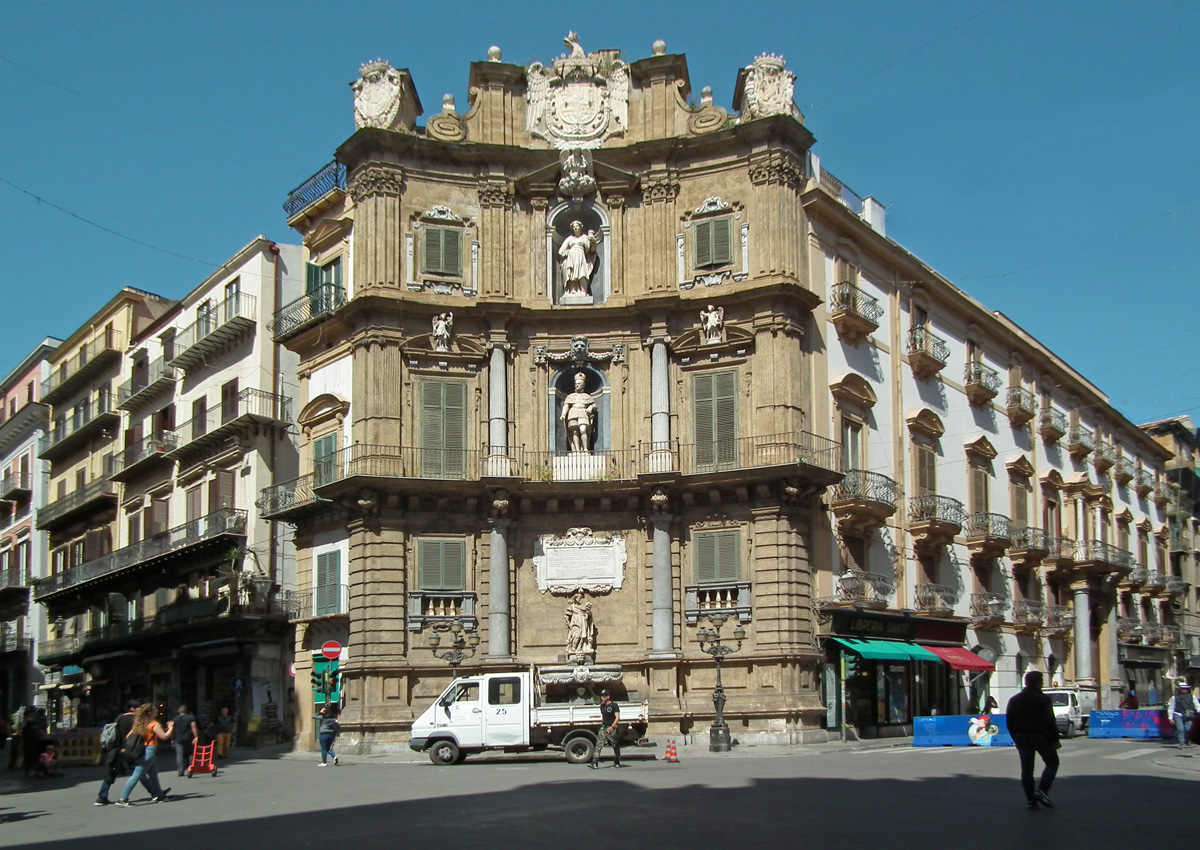 |
||||
| Palermo has such a rich history and such an abundance of sights to see that it is difficult to know where to begin. This circular intersection of two streets may be just the place to start our narrative. It is where the Via Vittorio Emanuele meets the Via Maqueda.
It is at the very heart of the Old City of Palermo. The intersection is called the Quattro Canti (which I think translates to "Four Songs"). In the photo above we see just one corner of the intersection. The other three corners are very similar architecturally although the statues and fountains on the buildings are all distinctive. The locals say that at any time of day, at least one corner will be lit by the sun. Most of the prime tourist sites are either on one of these two streets or close by. The Via Vittorio Emanuelle stretches in a North Easterly direction all the way from the Norman Palace to the Port of Palermo. |
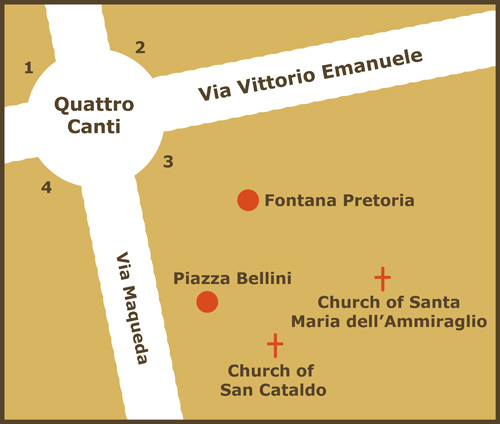 |
|||
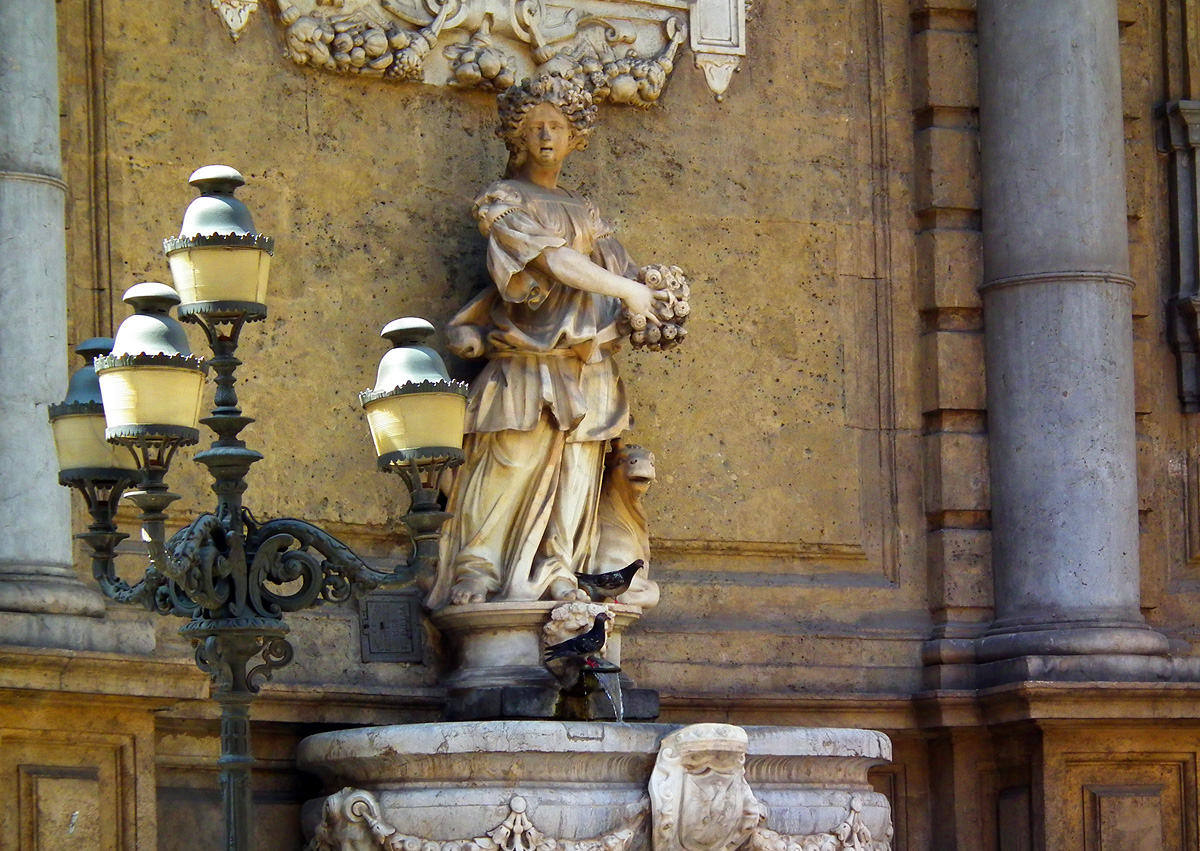 |
|||
| Each of the buildings of the Quattro Canti features statues, decorations and small water fountains. | |||
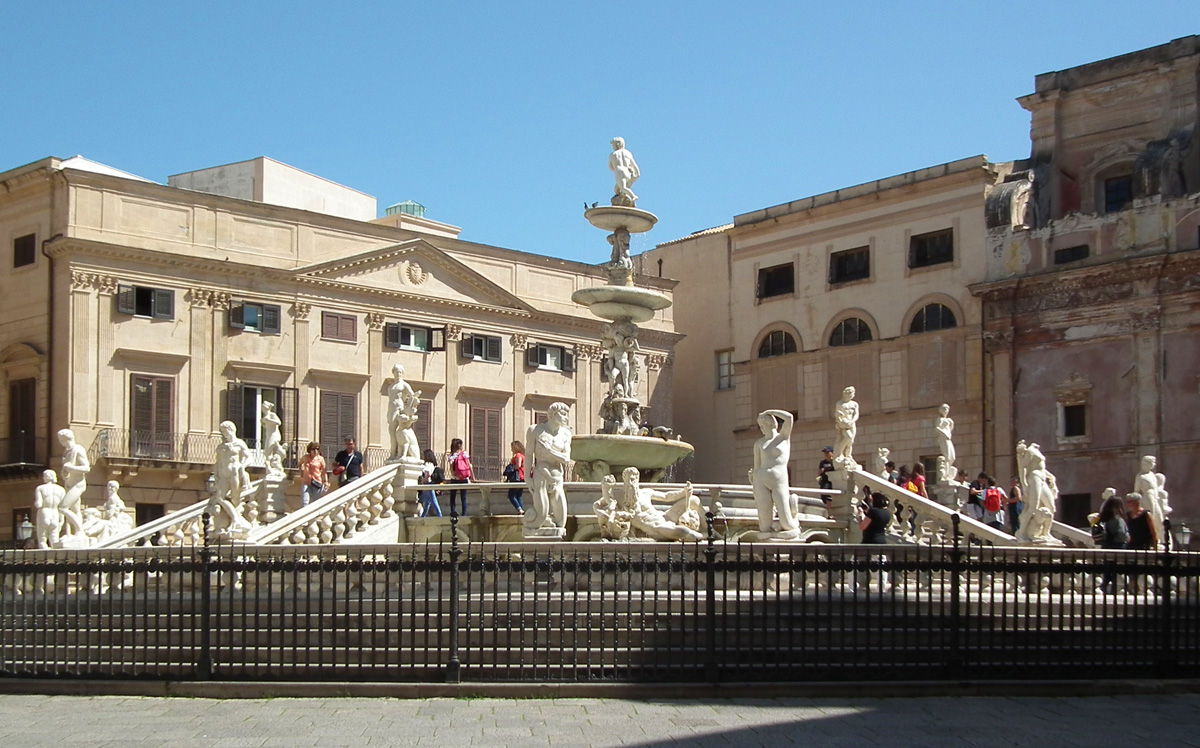 |
|||
| Off the Via Maqueda, literally a two minute walk from the Quattro Canti, we come across the Fontana Pretoria. This fountain was originally built in Florence in 1554 but because of the indebtedness of its owner, it was sold to the Senate of Palermo. It was then completely taken apart, transported in pieces to Palermo, and reassembled on its present site.
As you can see in the next photo, the statues of Gods and Goddesses are depicted in full glorious nudity and this apparently caused quite a stir in Palermo which at the time was quite a conservative town. The Fontana Pretoria later acquired the nickname "The Fountain of Shame". (Have a look at the little map above to show you where it is.) |
|||
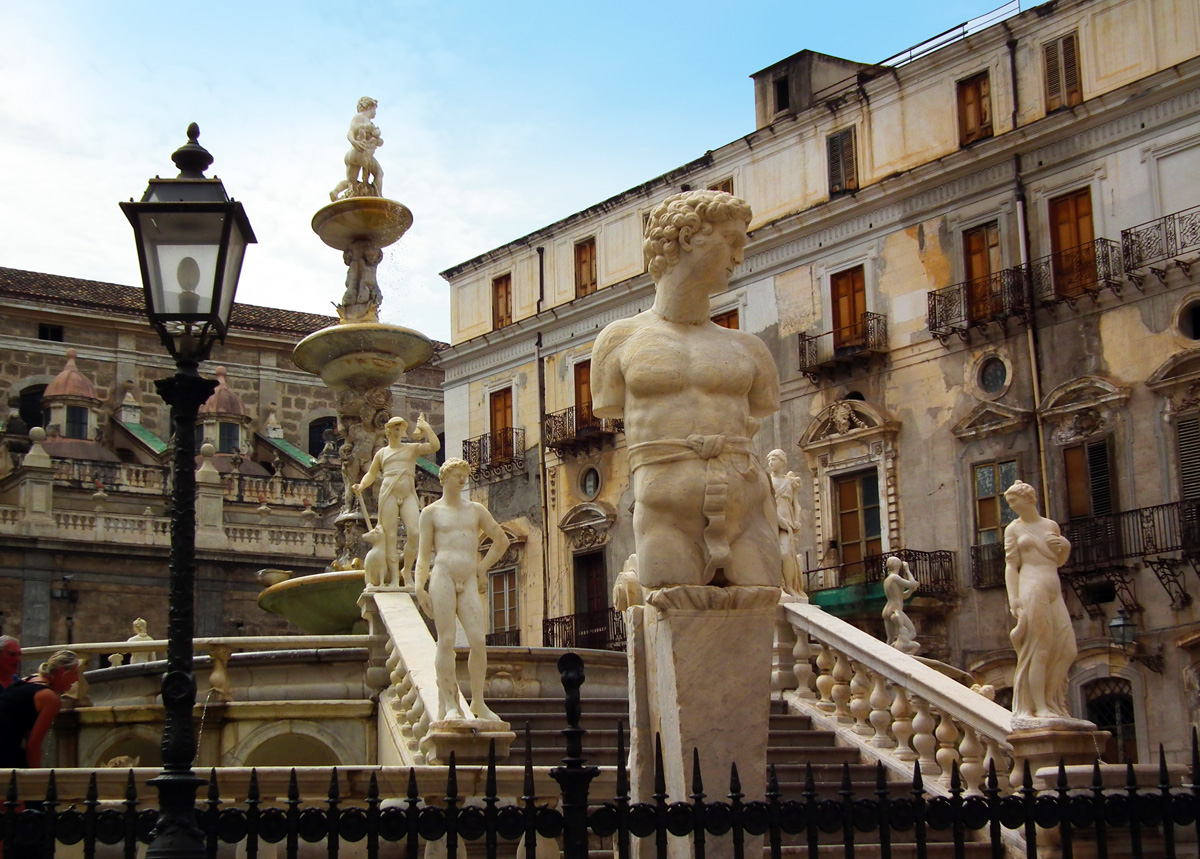 |
|||
| The statues depict the Twelve Olympian Gods. | |||
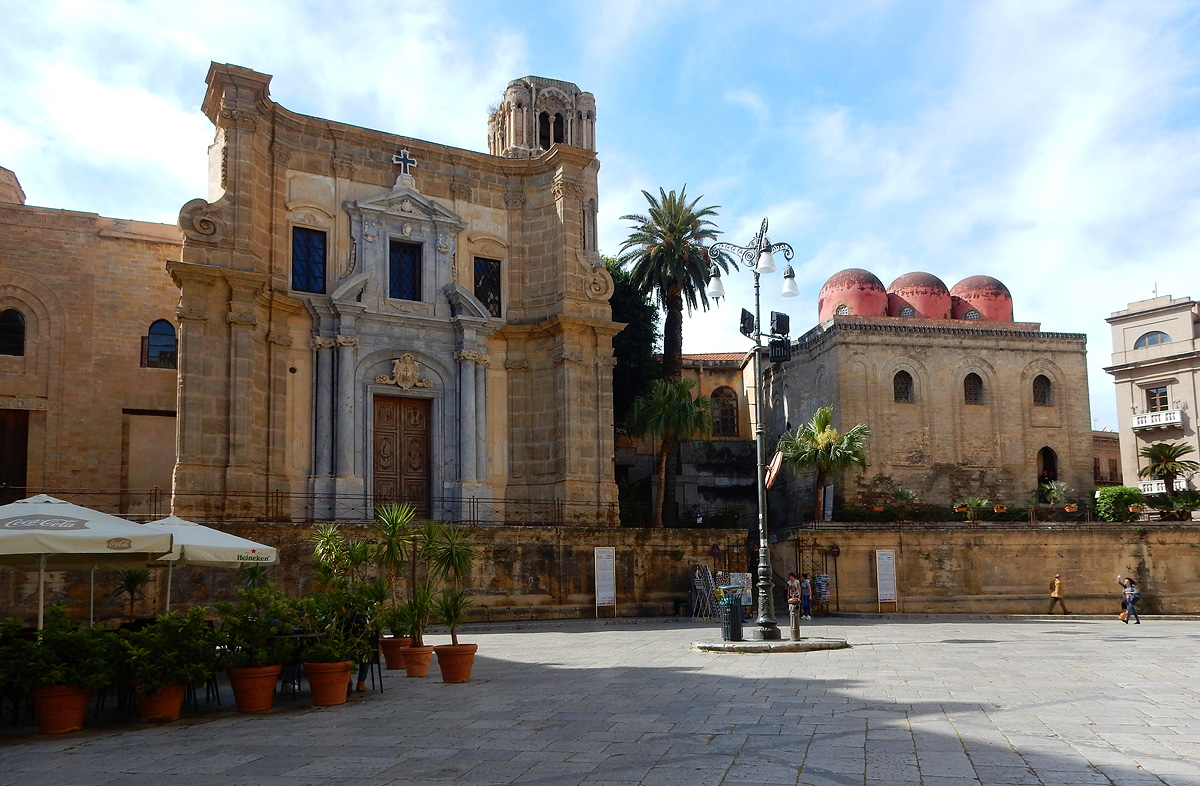 |
|||
| Still on the Via Maqueda, and just around the corner from the Fontana Pretoria, we find two fascinating Churches in the Piazza Bellini. The Church on the right with the three red domes is the Chiesa di San Cataldo. The one on the left is the Santa Maria dell'Ammiraglio (Martorana). The Martorana has a brilliant interior. | |||
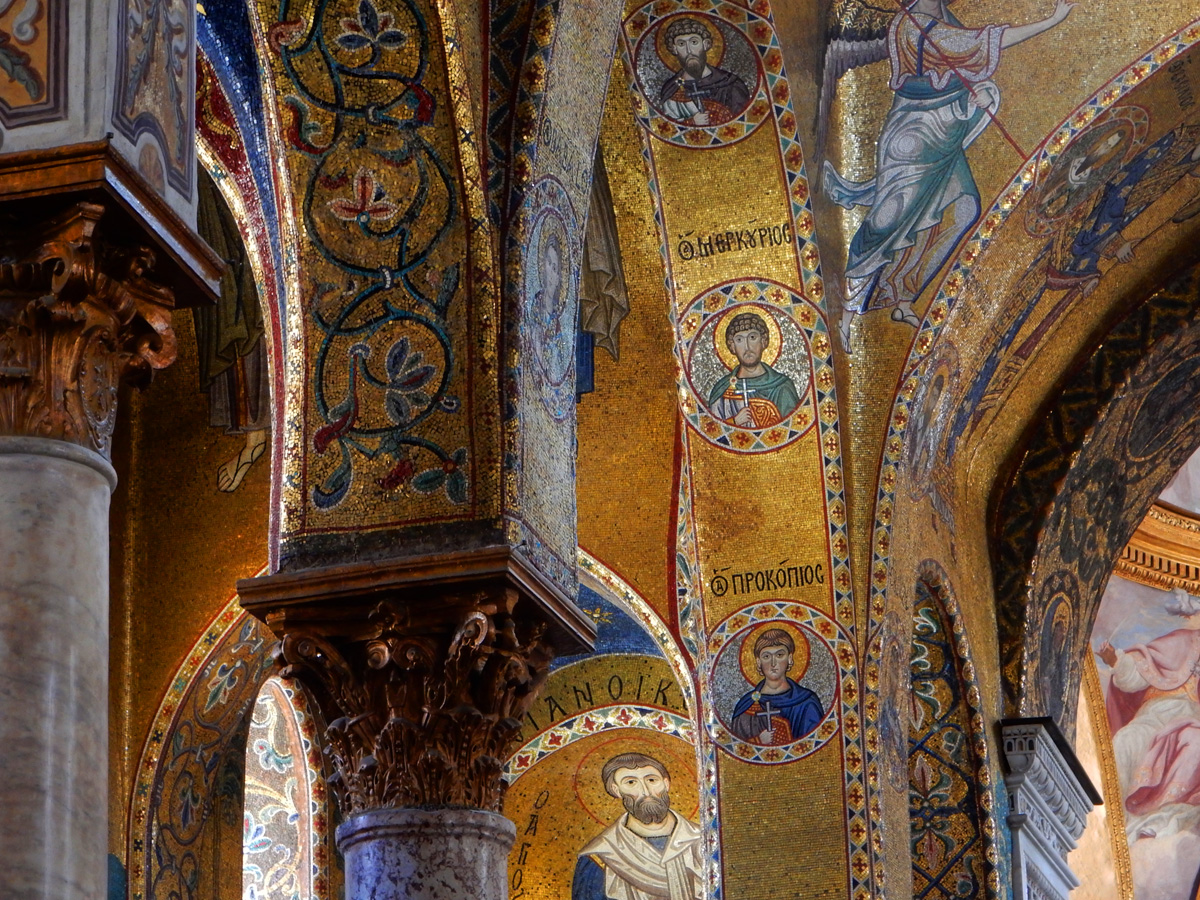 |
|||||||
| The Martorana is gorgeously decorated with an abundance of Byzantine mosaics, with a few Baroque frescoes added at a later date. It is an excellent example of the multicultural legacy of Roger II, who was an enlightened ruler of Sicily. It is worth spending a bit of time explaining Roger II's place in Sicilian history since it will help to place some of the best art and architecture in Sicily in their proper context. | Sicily has had a rich history. Around 1200 BC it was settled by an Italic people known as the Sicels. In 735 BC, the Ancient Greeks founded their first colony in Sicily at Naxos (just South of today's Taormina). This was quickly followed by the founding of Syracuse (Siracusa) in 733 BC. In 700 BC the Phoenicians (aka, the Carthaginians) established the Punic city of Zis (present day Palermo). There were constant wars between the Greek colonies and between the Greeks and the Carthaginians over the next few centuries. By 200 BC, Sicily had become the property of the young Roman Empire. Over the next few centuries, Rome and Constantinople took turns occupying Sicily.
In 827 AD, Sicily was for the first time attacked by Arab Muslims, and soon Sicily became governed by a succession of Arab Emirs. The Muslims ruled Sicily for the next two centuries. In 1072 AD, a Norman (read Viking) nobleman and adventurer called Roger of Hauteville succeeded in capturing Palermo and was invested as Roger I, Count of Sicily. He had a son who eventually became Roger II, and was anointed by the Pope as the first King of Sicily. Roger II became an enlightened ruler who allowed Arabs, Jews, Greeks and Romans to live in harmony during his reign. Roger II is credited with creating an artistic fusion of Byzantine, Arab, Norman and Roman art and architecture which is a pronounced feature of the most interesting and beautiful art which we can see in Sicily today. |
So far so good. But I have long been intrigued by the question of how the son of a rough Viking warrior (Roger I) became such an enlightened multiculturalist. So I started enquiring into THE MOTHER of Roger II, who turns out to have been a fascinating woman, and who certainly made her mark in Sicilian history.
Her name was Adelaide del Vasto and she was born in the North of what we now call Italy. In 1089 AD, when she was just 14, she married Roger I, who was then 58 years old. It was his third marriage. They had two sons, Simon and Roger II. When Roger I died, Adelaide was only 26, but she became the Regent of Sicily as her eldest son, Simon, was only 9 at the time. Simon died at the age of 12, so his younger brother, Roger II, became the Count of Sicily at the tender age of 10. Adelaide continued as Regent until Roger II took control in 1112 AD. (Roger II became the first King of Sicily in 1130 AD.) There is ample evidence to suggest that Adelaide was instrumental in establishing the policy of using local officials to help govern the territory, as well as ensuring that the various ethnic and religious groups in Sicily were protected and allowed to live their lives in harmony and without fear of persecution. What a woman! Oh, and in case you might think from reading the above that Adelaide del Vasto was just a soft, bleeding-heart liberal, she was quite capable of using "severe force" to put down rebellions in Sicily and Calabria. I repeat: What a woman! |
|||||
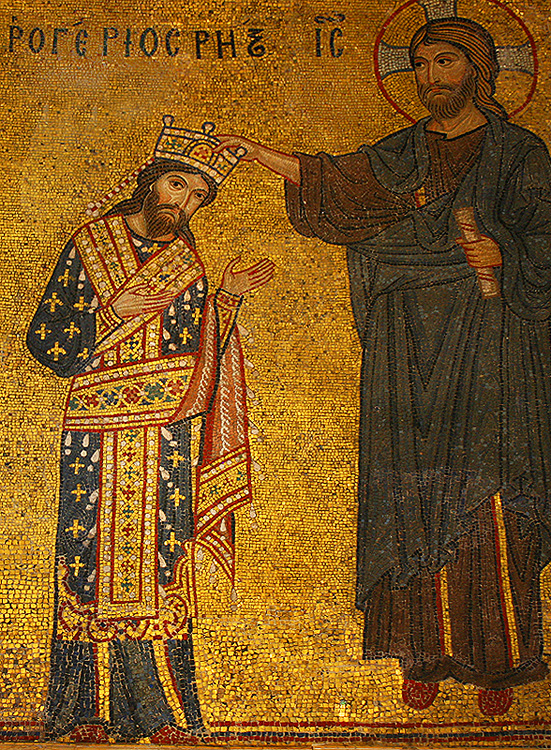 |
||||
| Here is a mosaic in the Martorana which suggests that it was Jesus Christ who had annointed Roger II as King of Sicily. History records that it was Pope Honorious II. | ||||
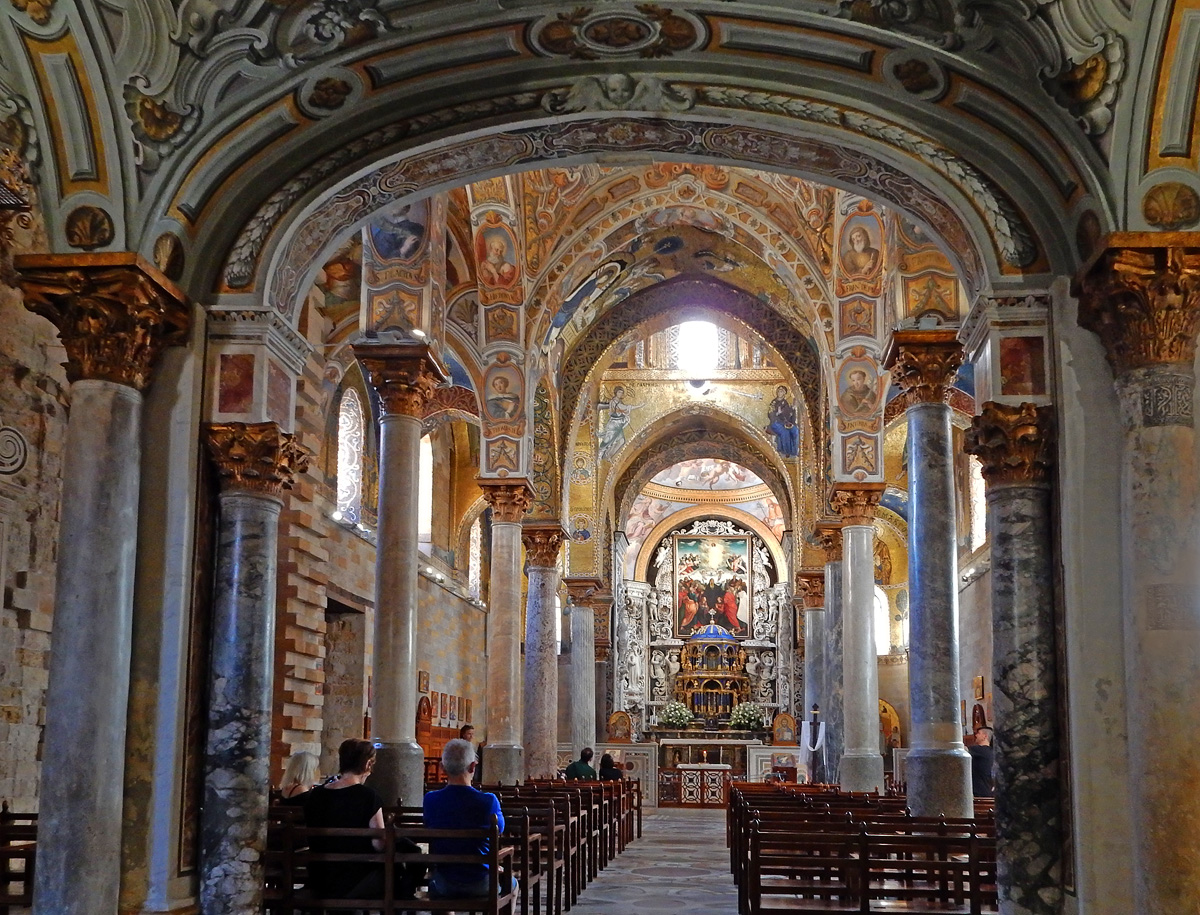 |
|||
| The next few photos reveal the scale and the splendour of Santa Maria dell'Ammiraglio Martorana. | |||
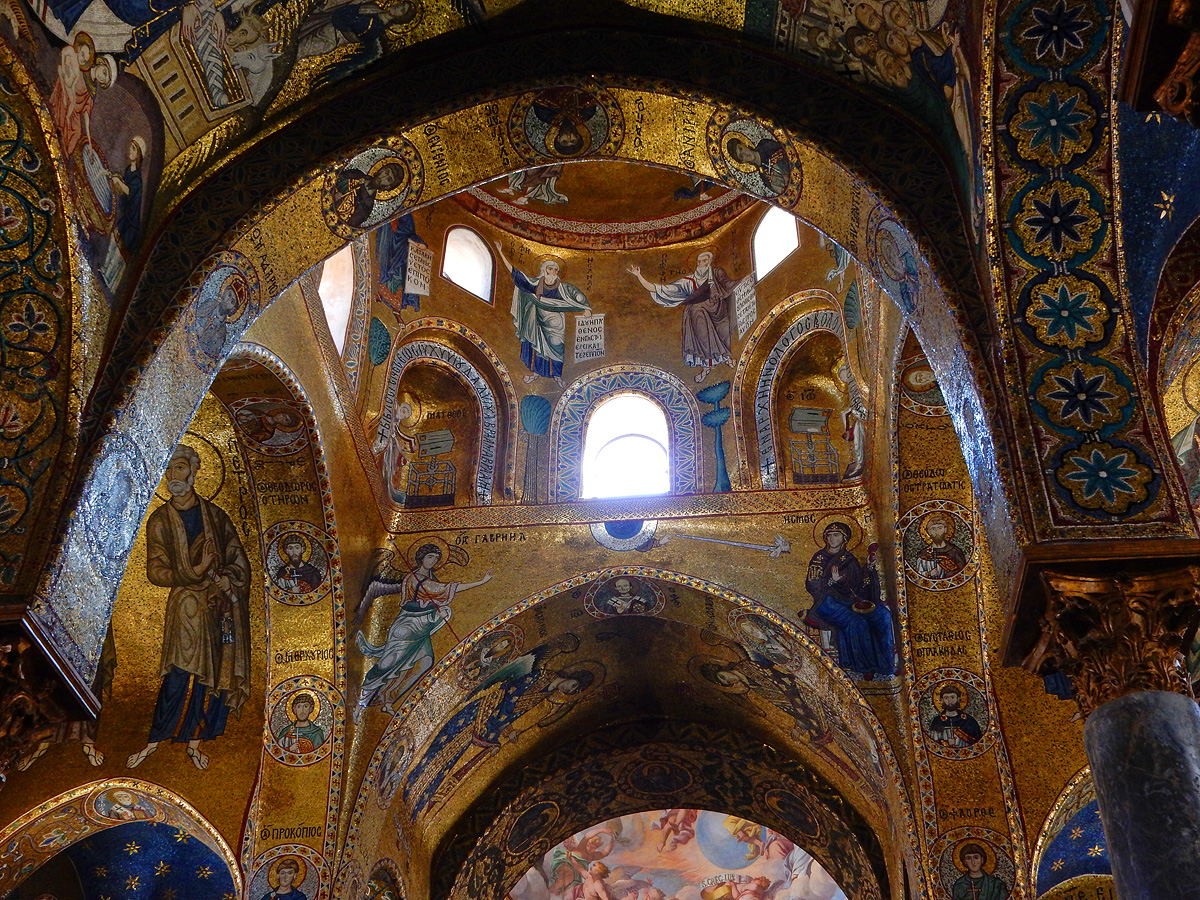 |
||
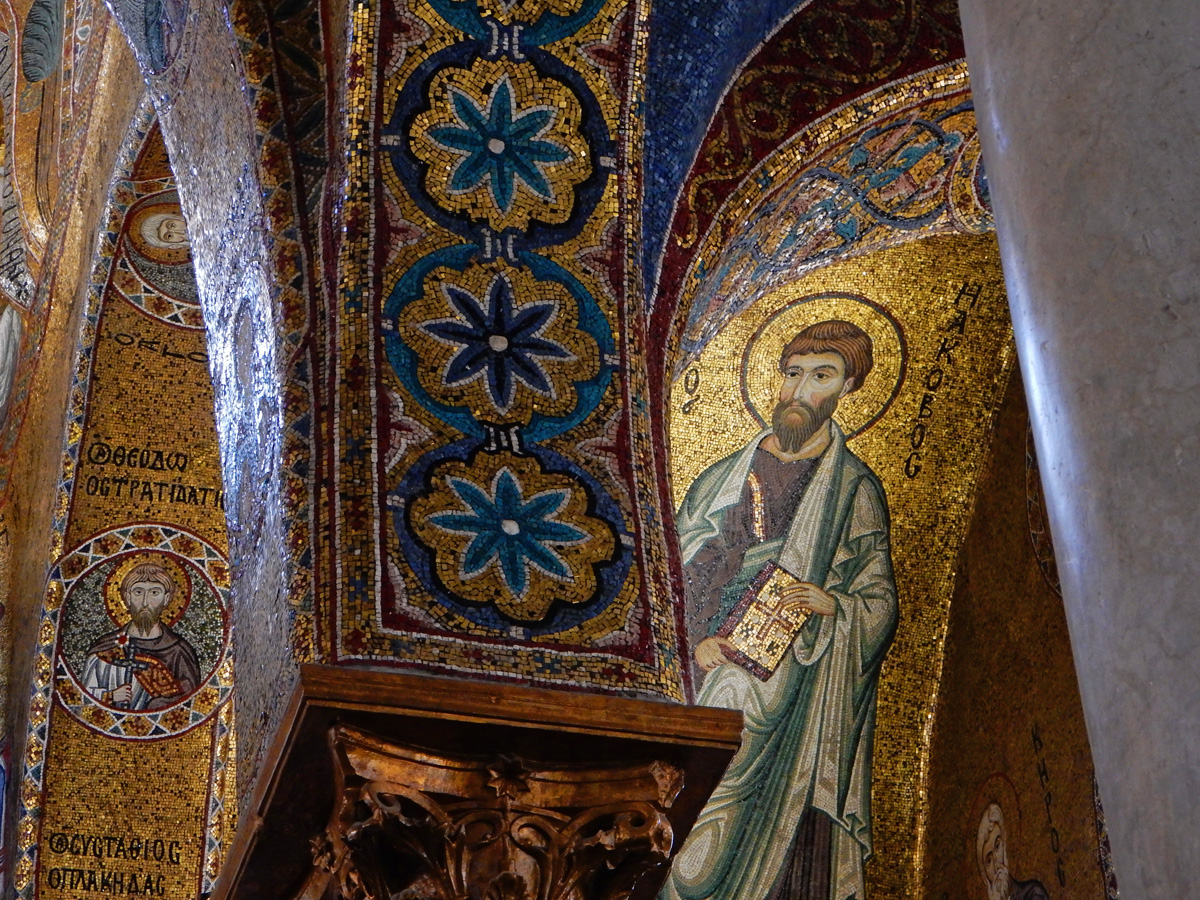 |
||
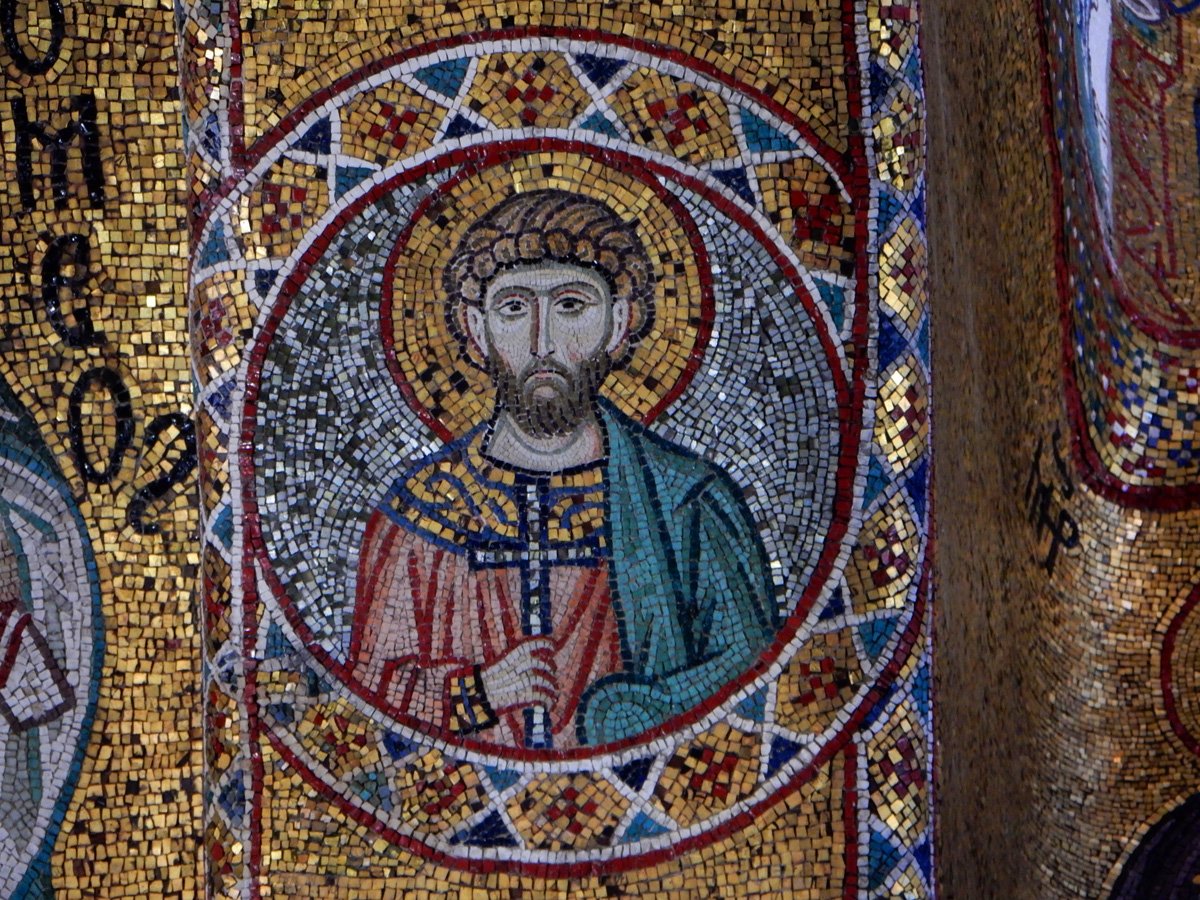 |
||
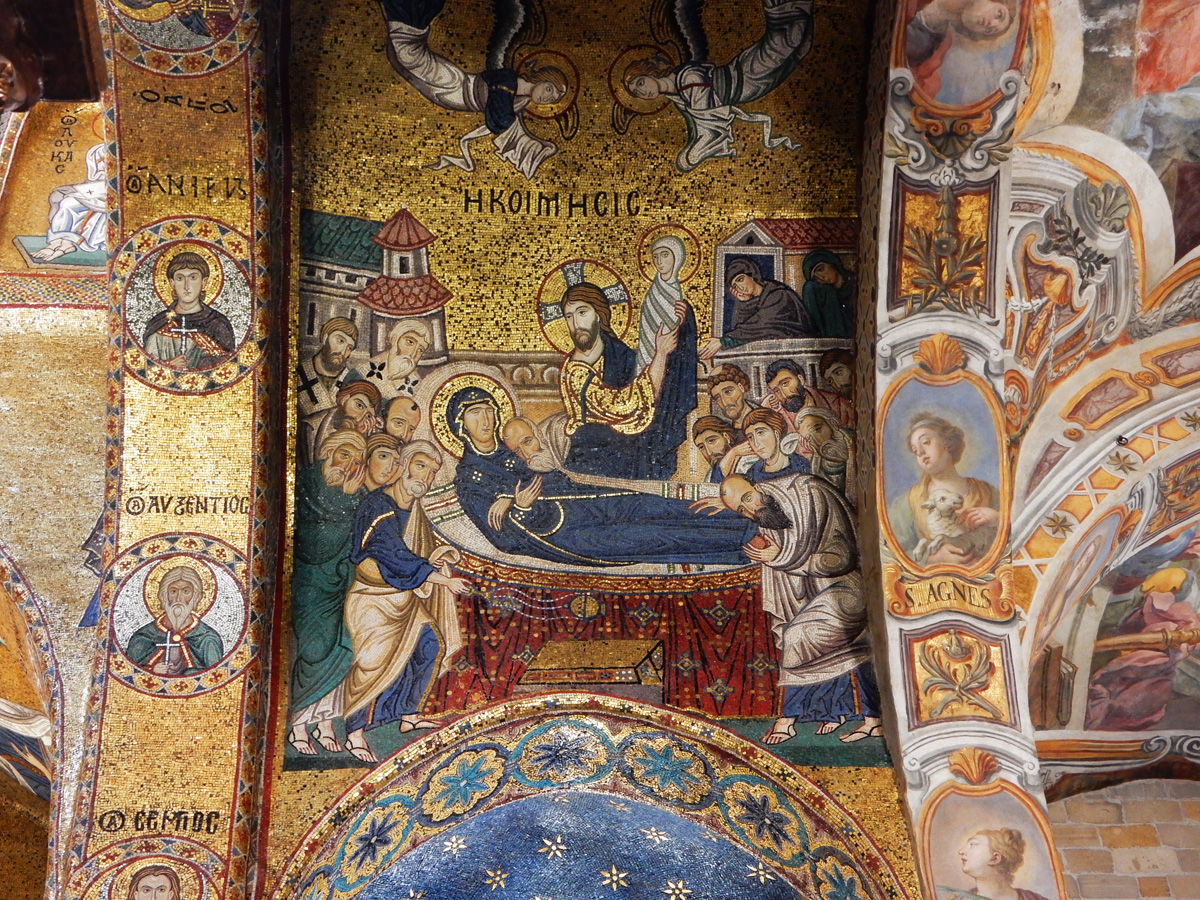 |
|||
| There seems to have been a tendency in times past to think that New was always better than Old. This stupidity often led to the mindless destruction of old decoration to be replaced with the latest fashion of the day.
We have thus lost much of the Arab and Byzantine art and architecture of Sicily (and elsewhere, alas). Fortunately, in this church, there is still much of the Old left for us to enjoy and admire. Methinks that it is largely thanks to present day mass tourism that the idea of preserving heritage has become popular once again. Hooray! (Let's face it: would you spend a small fortune to travel overseas in order to look at a bunch of cold, glass office blocks?) |
|||
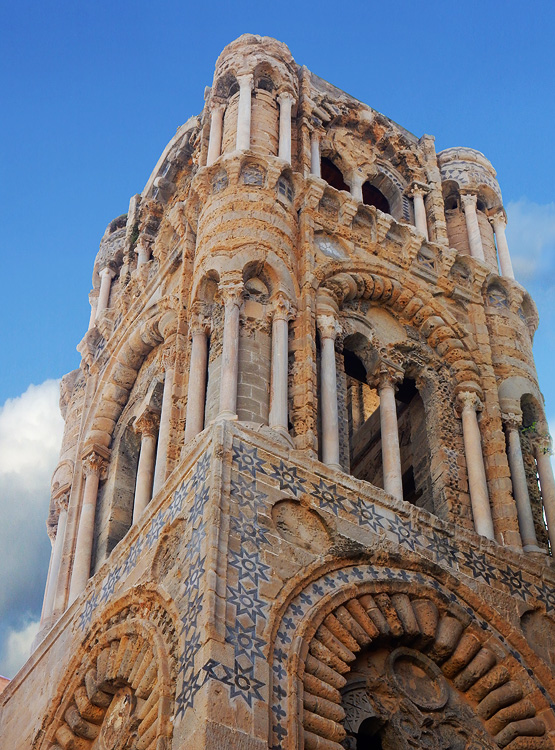 |
||||
| The Romanesque (Norman) bell-tower of Santa Maria dell'Ammiraglio.
Note the Arabic 8-pointed stars on the lower part of the tower. |
||||
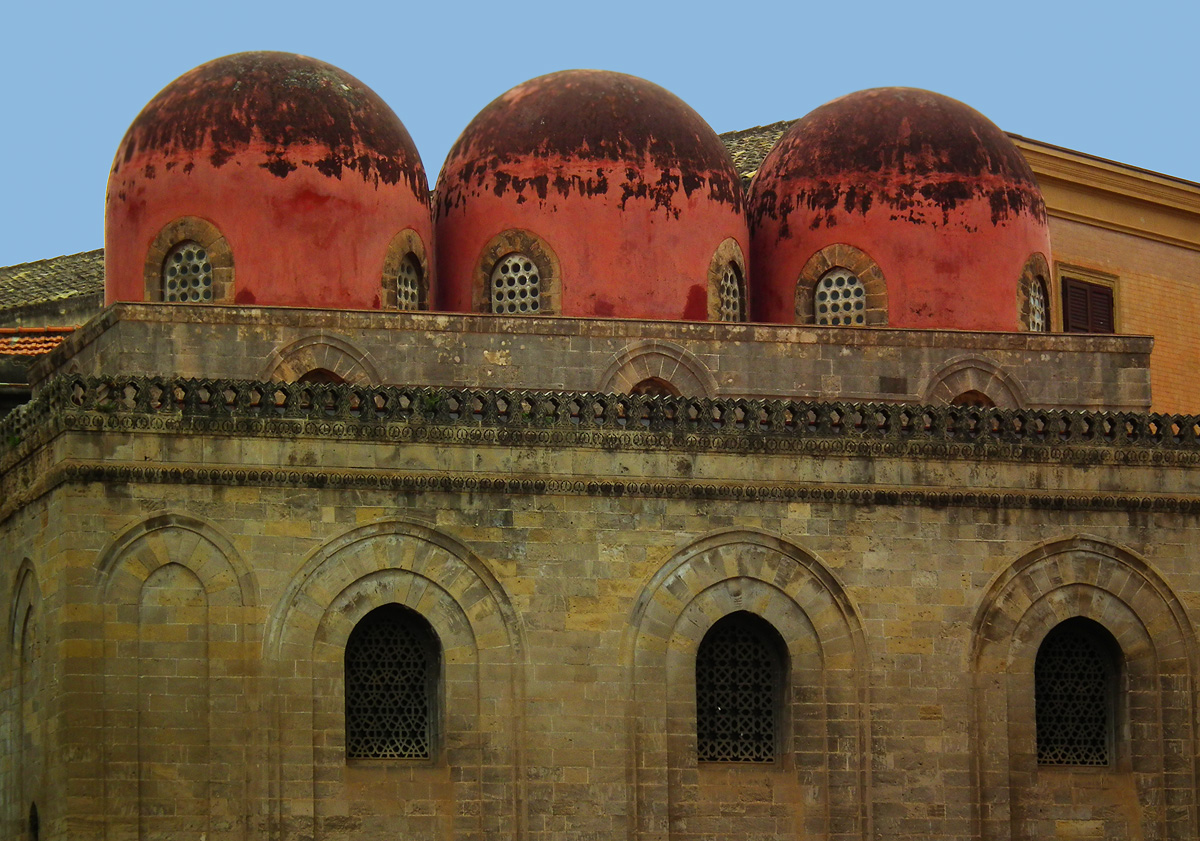 |
|||
| A close up shot of the three red domes. The Church of San Cataldo was erected in 1154 and was an expression of the type of Arab-Norman architecture which flourished during the magnificent reign of Roger II of Sicily.
Unfortunately, the interior of San Cataldo has been ravaged over the centuries and is now not worth seeing, in my opinion. Others may disagree. |
|||
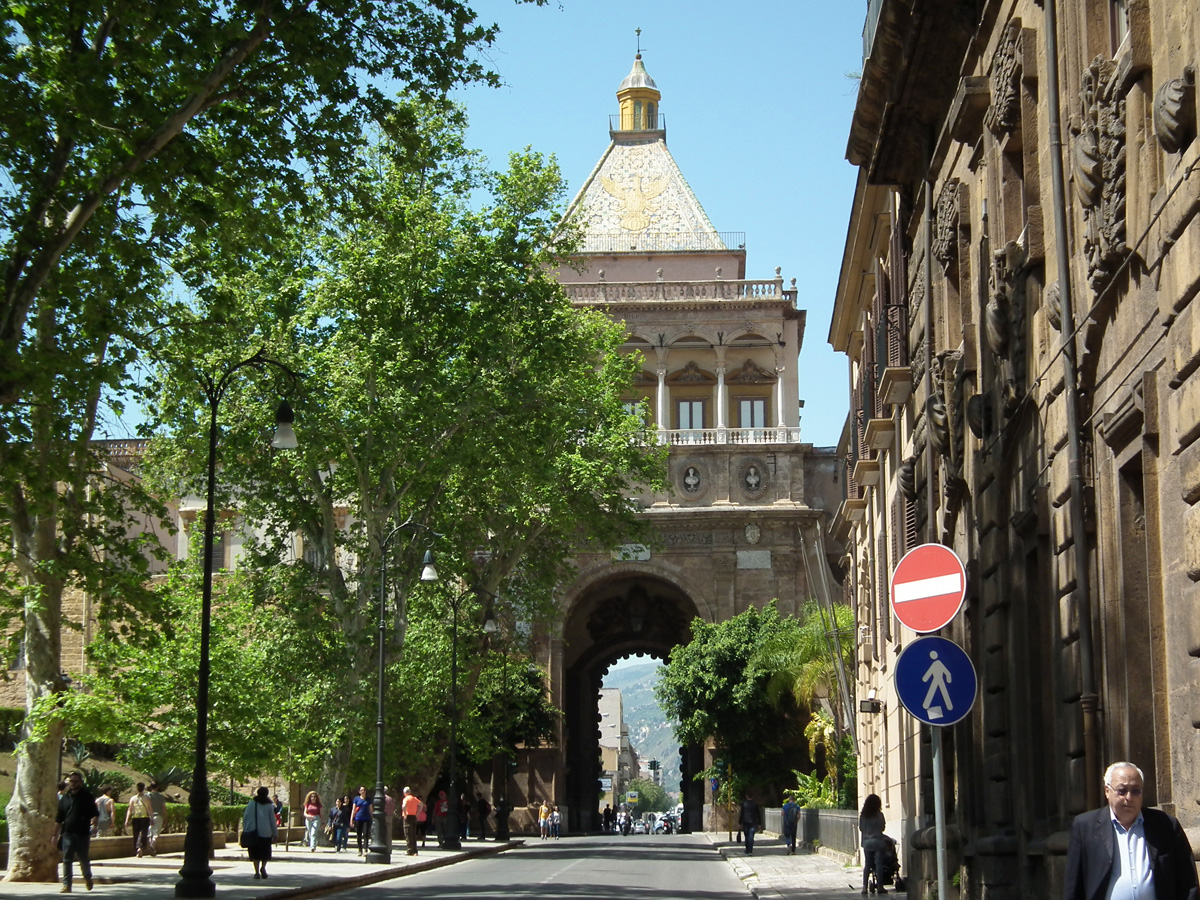 |
|||
| We now visit the South Western end of the Via Vittorio Emanuele. Facing us is the Porta Nuova (the New Gate). It is part of the Norman Palace, built during the time of Roger II, although the Porta Nuova itself has a Renaissance air to it.
The Park on the left is part of the Villa Bonanno. |
|||
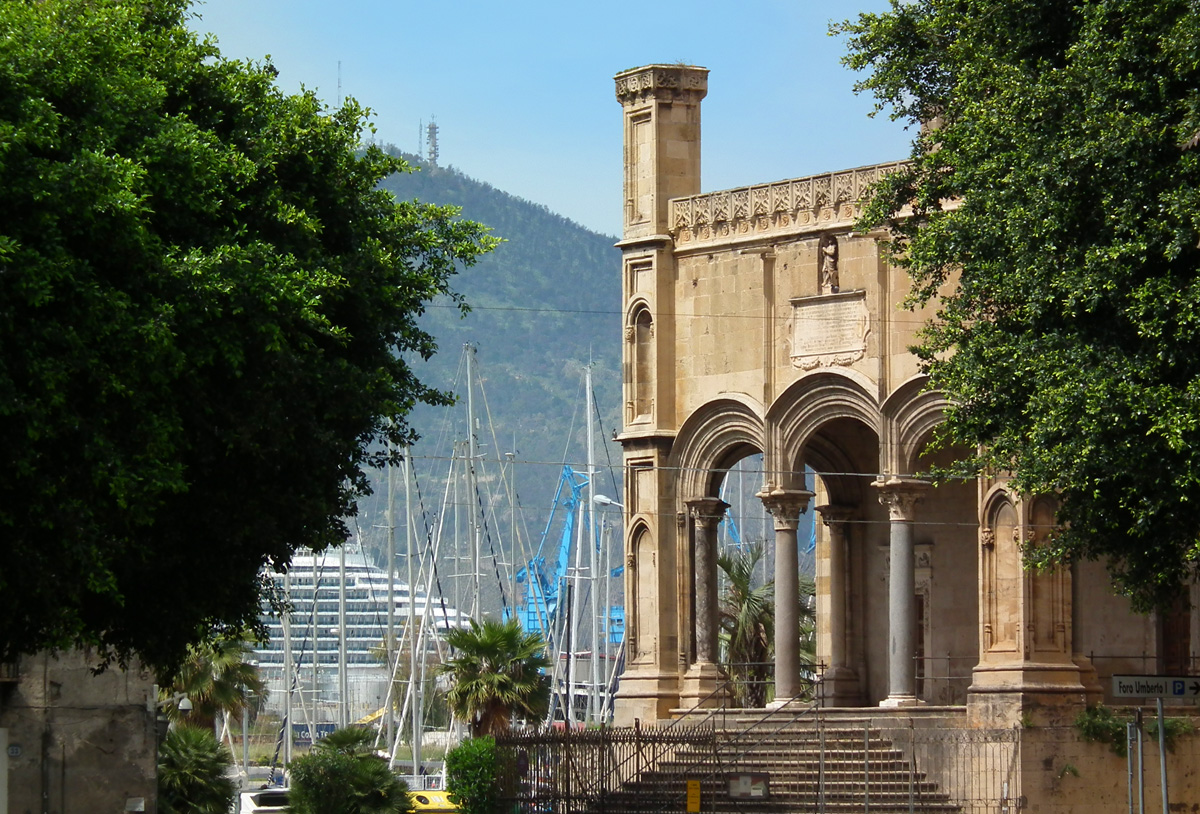 |
|||
| At the opposite (North Eastern) end of the Via Vittorio Emanuele there is another gateway, called the Porta Felice, through which we can see glimpses of the Port of Palermo. | |||
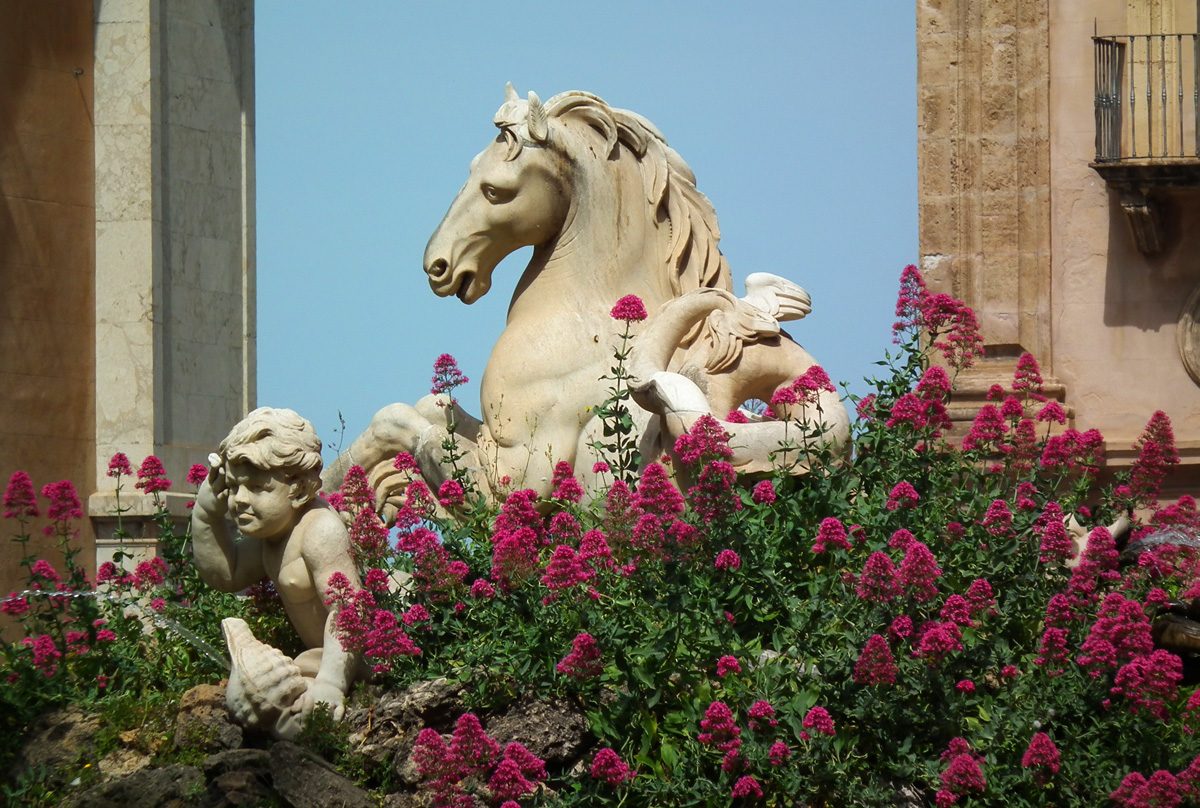 |
|||
| This equine sculpture is at the Porta Felice. | |||
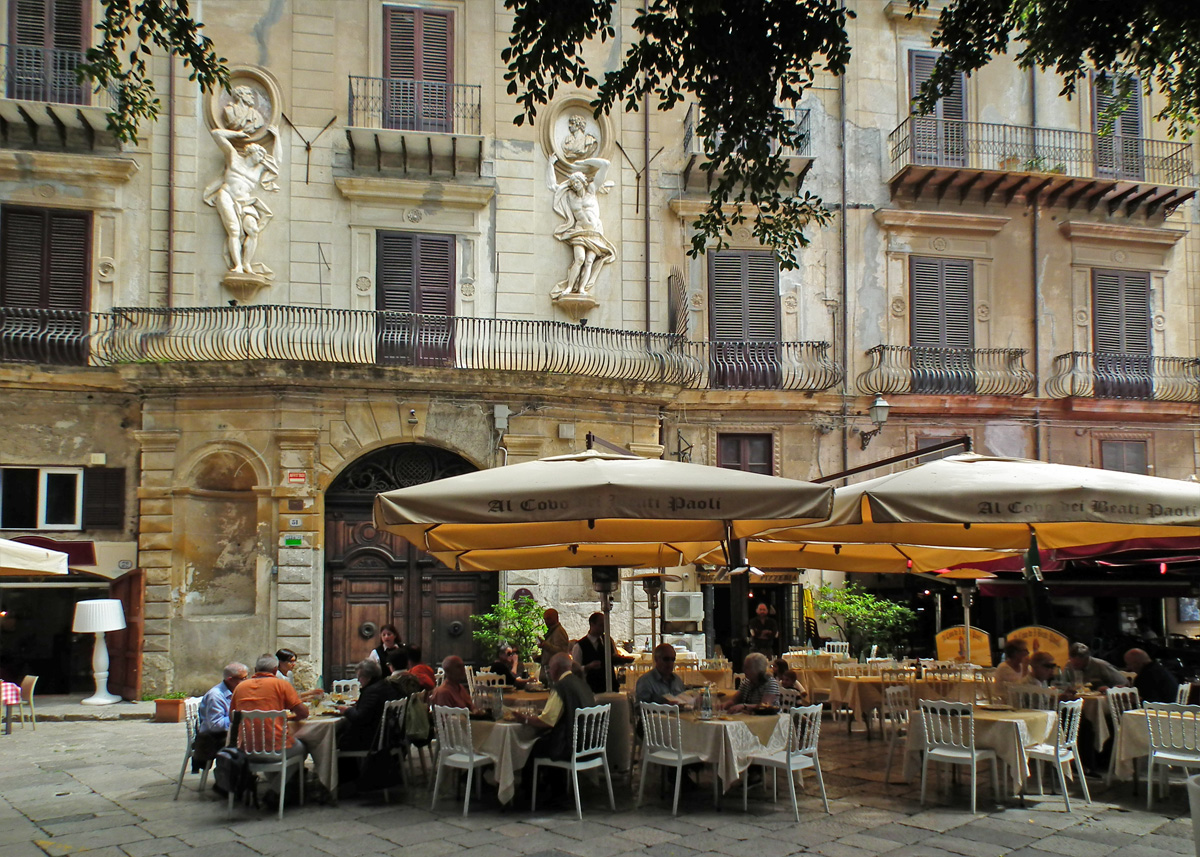 |
|||
| The tradition of outdoor dining is very popular in the whole of Sicily. This cafe is pretty close to the Porta Felice.
The balustrades and statues on the building behind the cafe are typical of the old facades of Palermo. |
|||
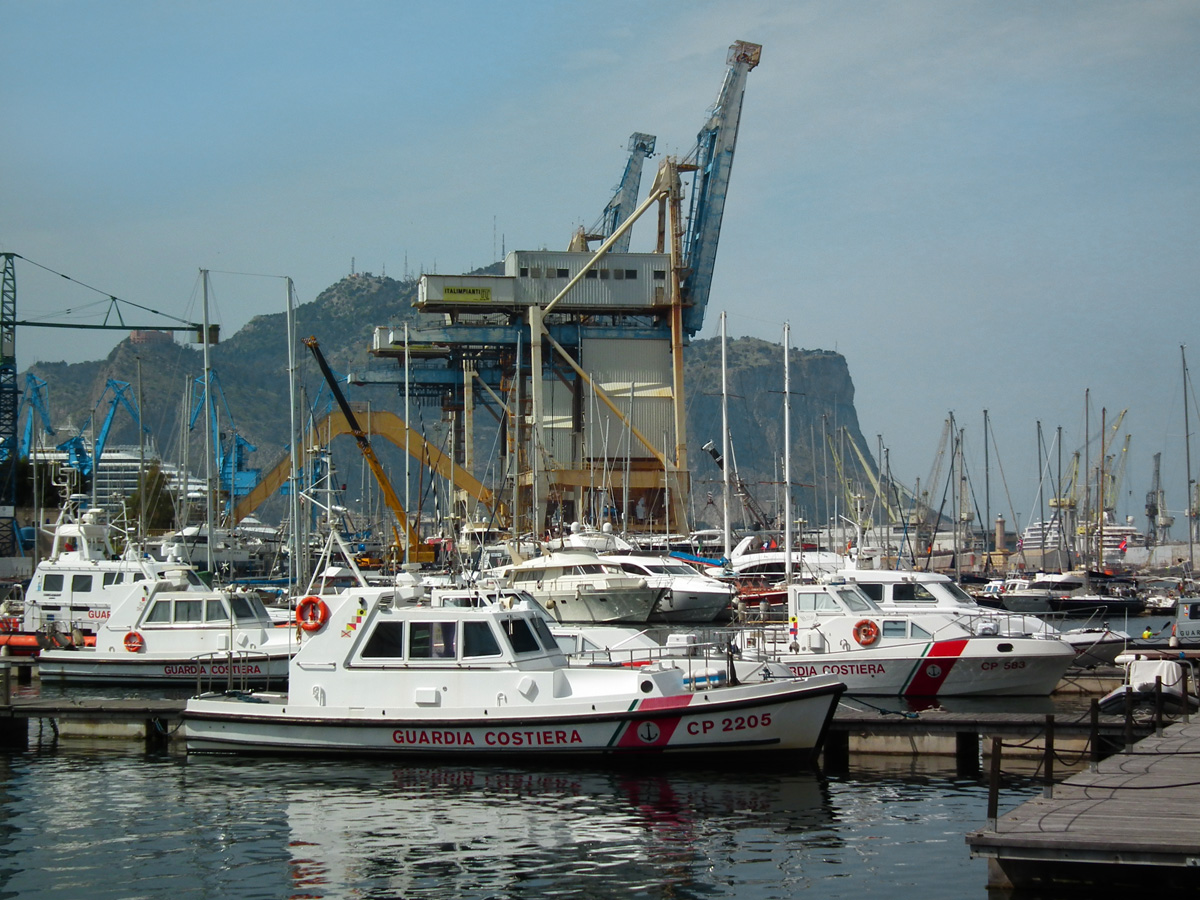 |
|||
| Palermo has been an important port since the time of the Carthaginians. | |||
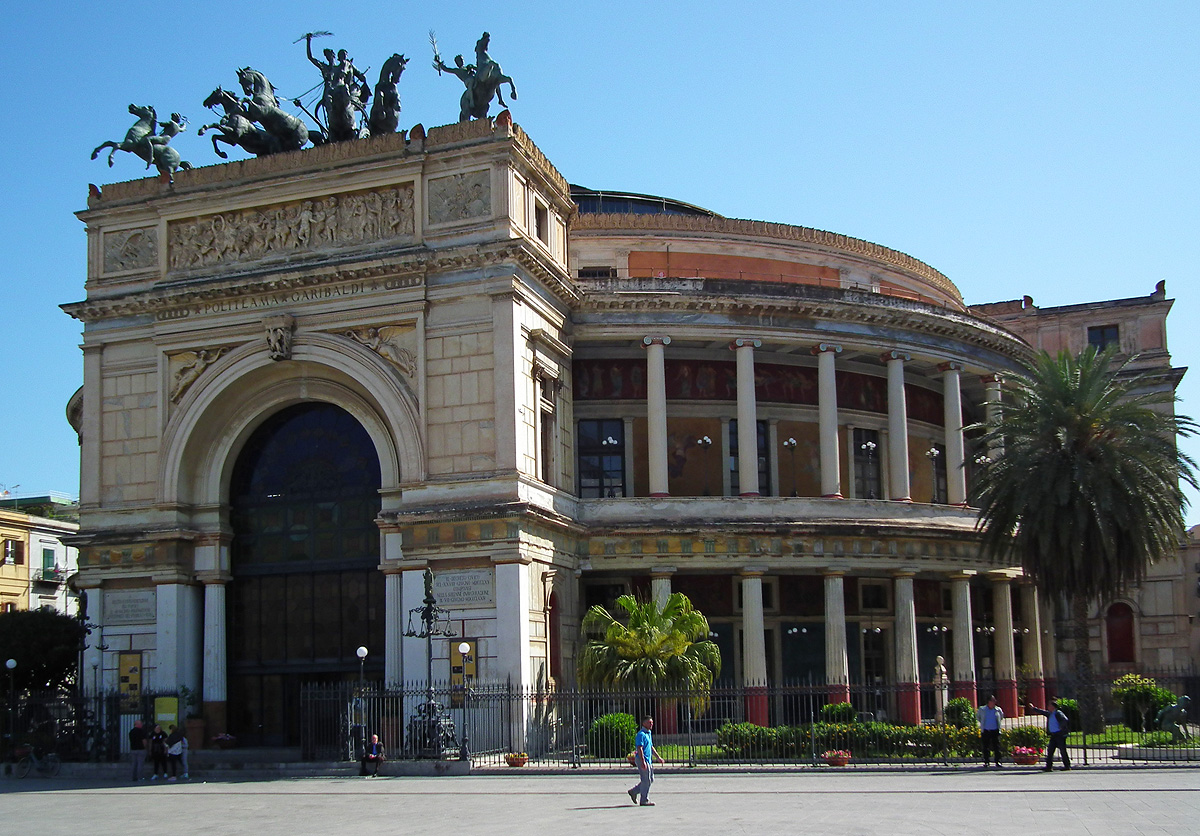 |
|||
| A little to the North of the Via Vittorio Emanuele, near the Via Turati, we come across the Teatro Politeama Garibaldi. The theatre is in the Piazza Roggero Settimo. It is now the headquarters of the Orchestra Sinfonica Siciliana. | |||
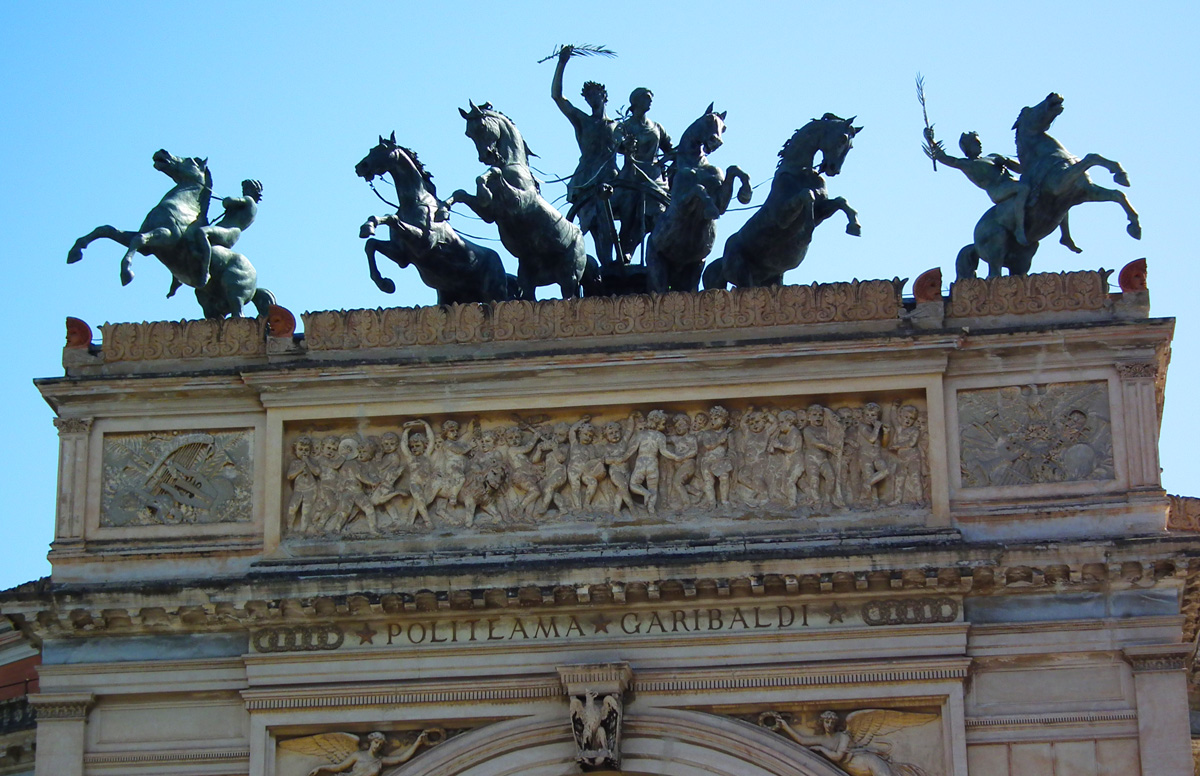 |
|||
| A close-up shot of the bronze horses and riders atop the Teatro Politeama.
Take a closer look at the young kids playfully cavorting on the marble frieze just below the horse sculptures. |
|||
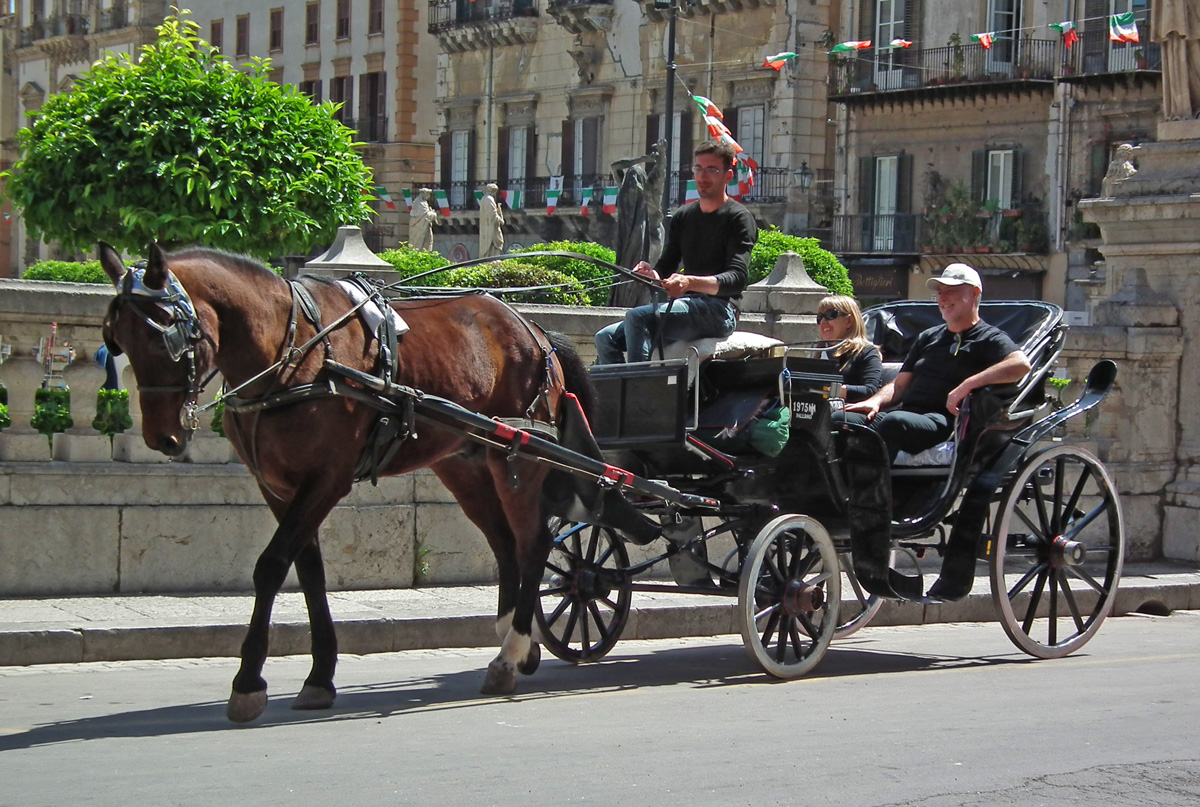 |
|||
| This horse and carriage was to be seen on one of the wider boulevardes of Palermo, pretty close to the Teatro Politeama. | |||
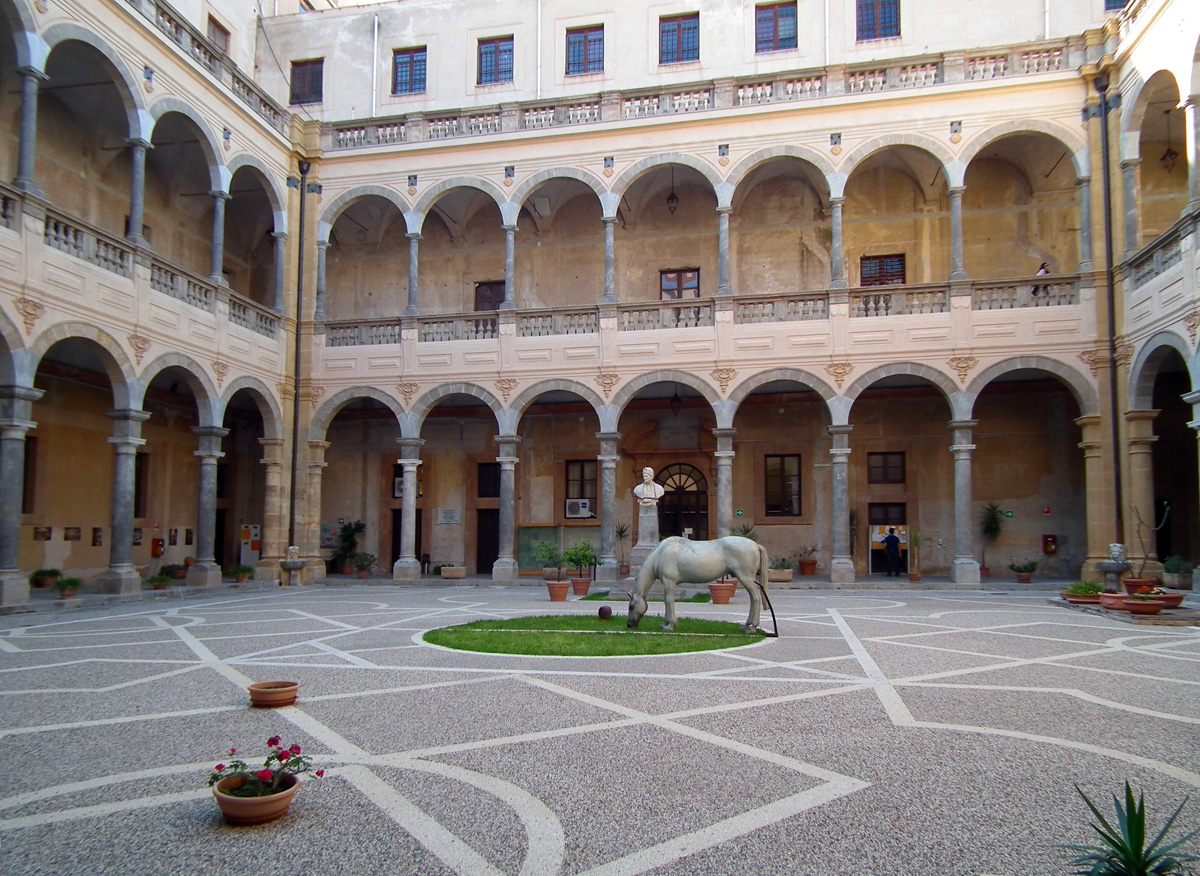 |
|||
| This is the Renaissance courtyard of the Central Library of Palermo (Biblioteca Centrale della Regione Siciliana). It is on the Via Vittorio Emanuele. | |||
 |
|||
| These buskers were doing their thing close to the Central Library on the Via Vittorio Emanuele. | |||
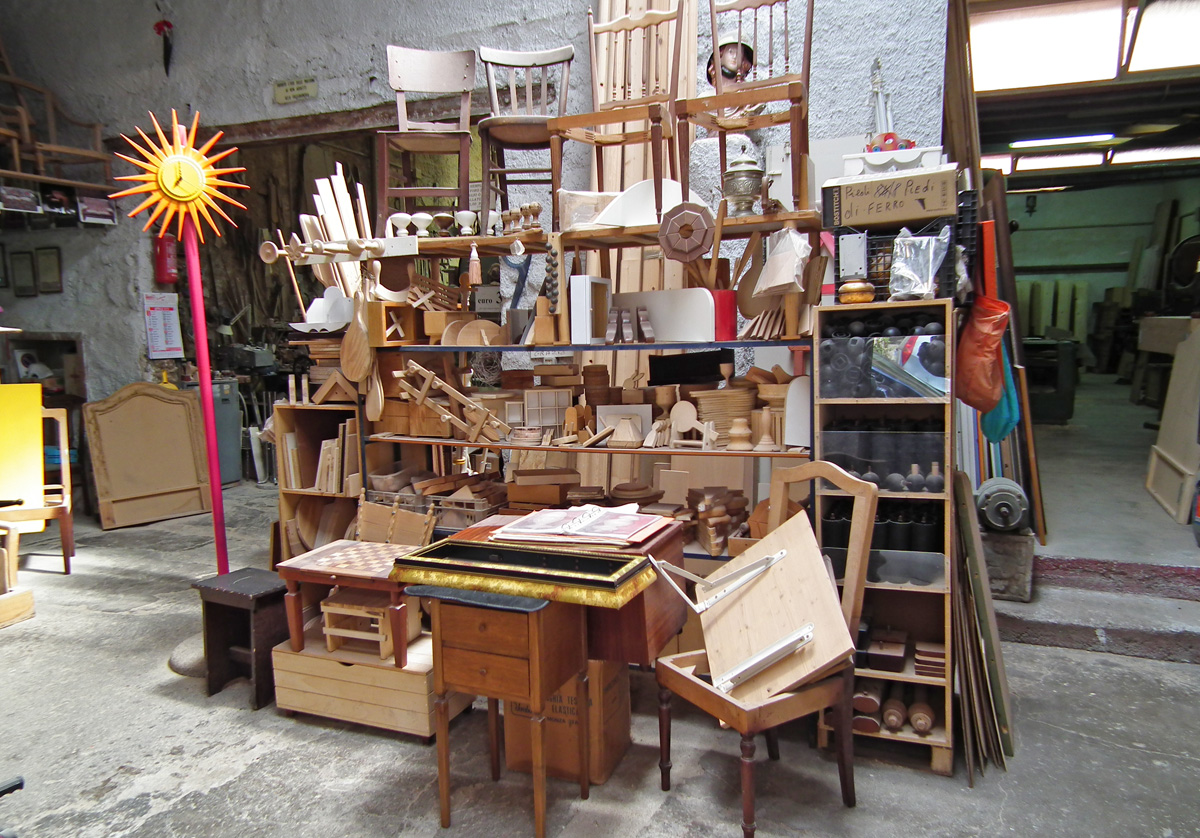 |
|||
| In case you might think that Palermo is just made up of expensive, up-market tourist destinations, let me remind you that it is also a gritty, large city which certainly adds to its charms in my book. Unlike some of my friends who are rich and who stay in posh hotels when they travel abroad, this poor, retired artist tends to stay in less salubrious areas where the B&B rates are significantly cheaper!
Alas, I have acquired the nickmane of "Tightarse Paul". However, staying in the not-so-posh districts of towns and cities can have its advantages. Here I stumbled across a wood-working shop which had a distinct woody smell. |
|||
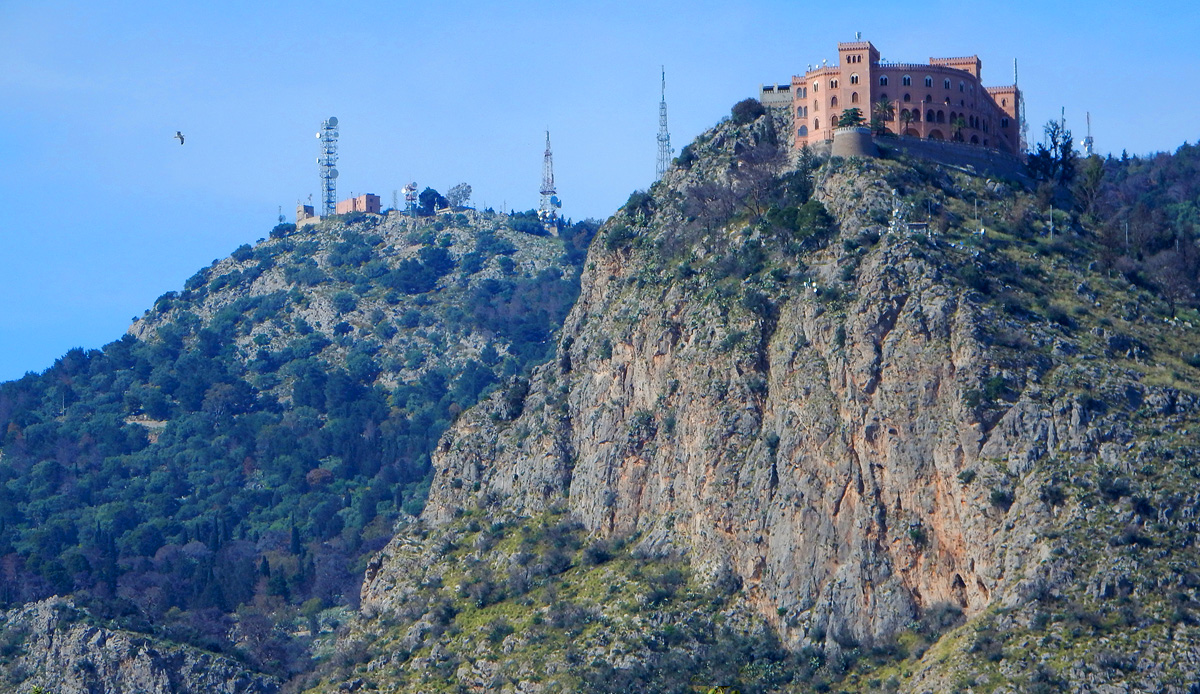 |
|||
| Just to the North of my B&B is this large hill with a sanctuary at its summit. It is the Santuario Santa Rosalia. | |||
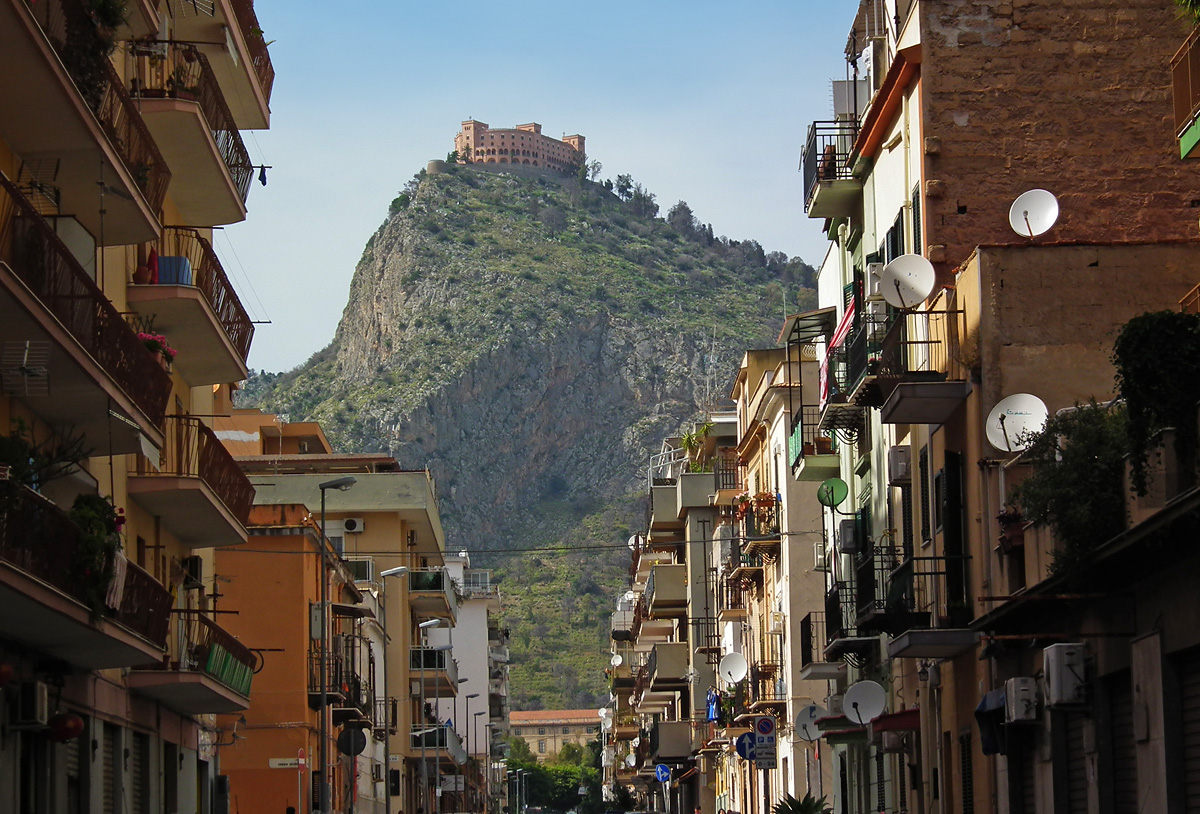 |
|||
| Here the Santuario Santa Rosalia is framed by the apartment blocks near my B&B. | |||
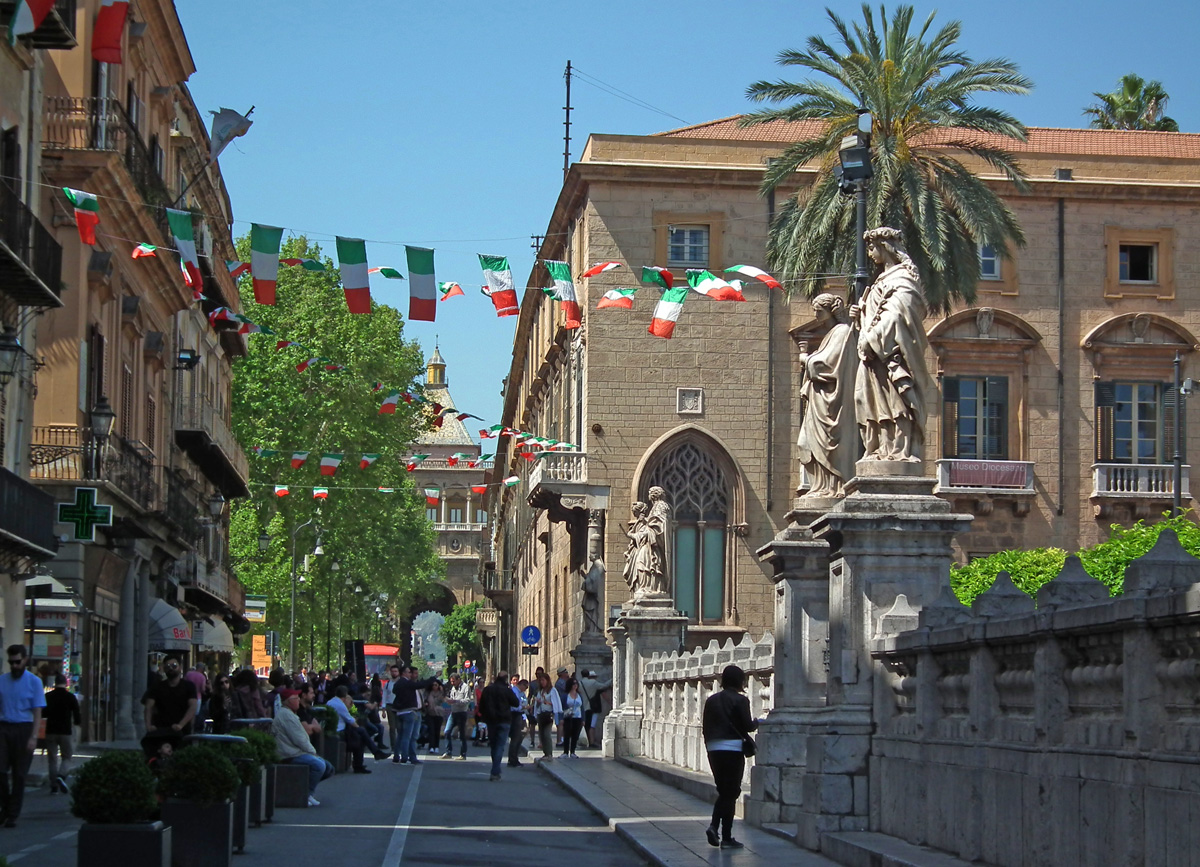 |
|||
| Back in the salubrious Via Vittorio Emanuele, we see the Porta Nuovo in the distance, and, to our right, we see some statues which tell us that we have arrived at the Cathedral of Palermo. | |||
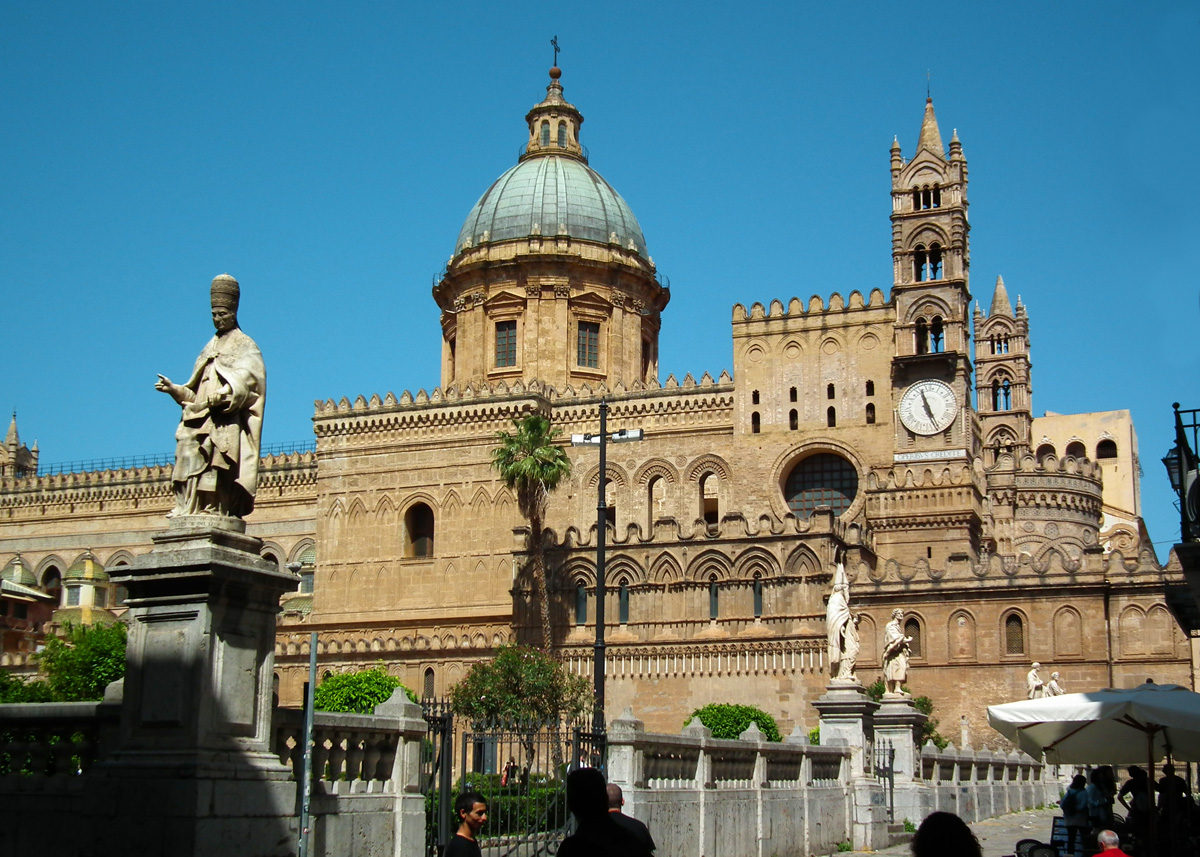 |
|||
| The Duomo (Cathedral) of Palermo. The Cathedral was first erected in 1185 by Walter Ophamil, the Anglo-Norman archbishop of Palermo. It replaced an earlier Byzantine basilica.
It was converted to a mosque after the Arab conquest of Sicily in the 9th Century. Much of the building has since been altered according to the fashions of the day, and it now has an interior which is predominatly classical Renaissance in style. |
|||
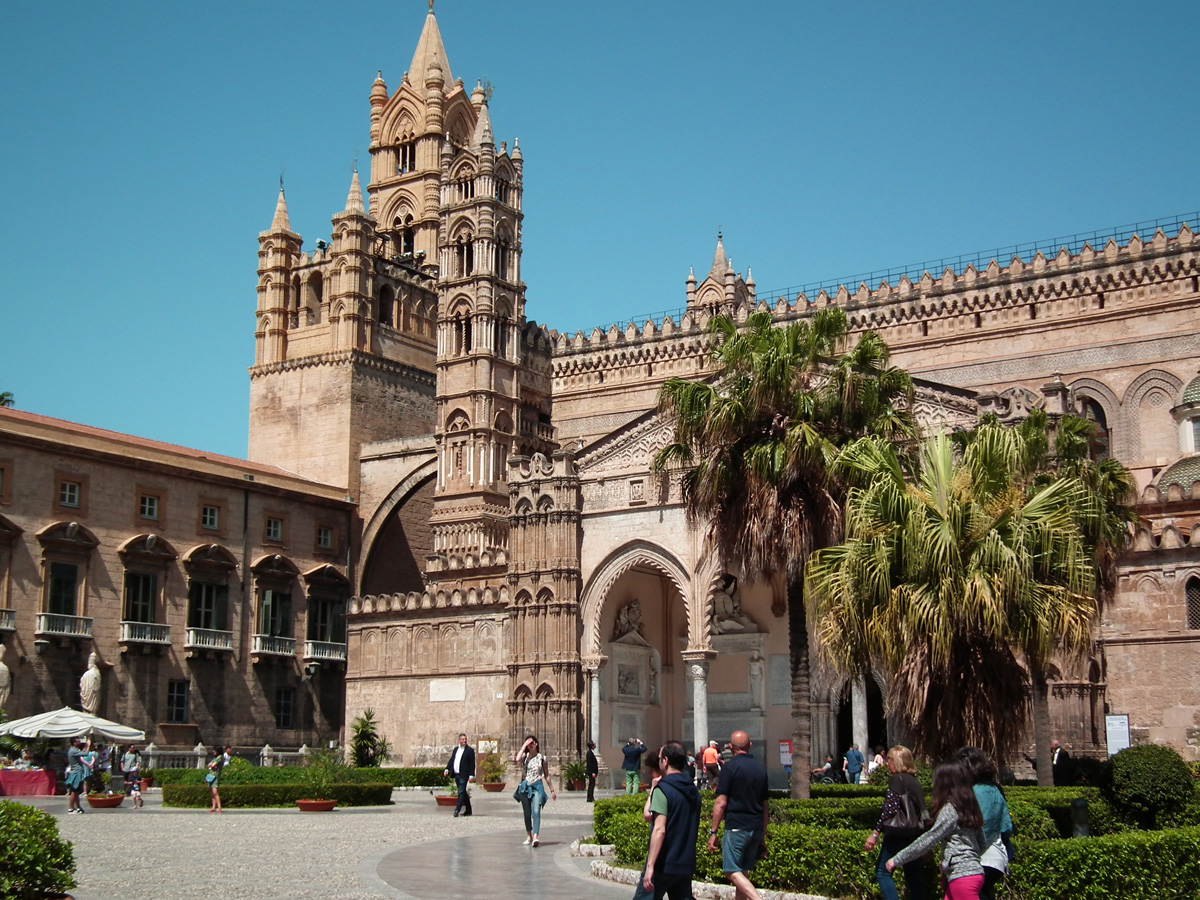 |
|||
| Another view of the exterior of the Duomo. I couldn't figure out if the tower on the left was part of the Duomo, or was attached to an administrative building across a narrow street. | |||
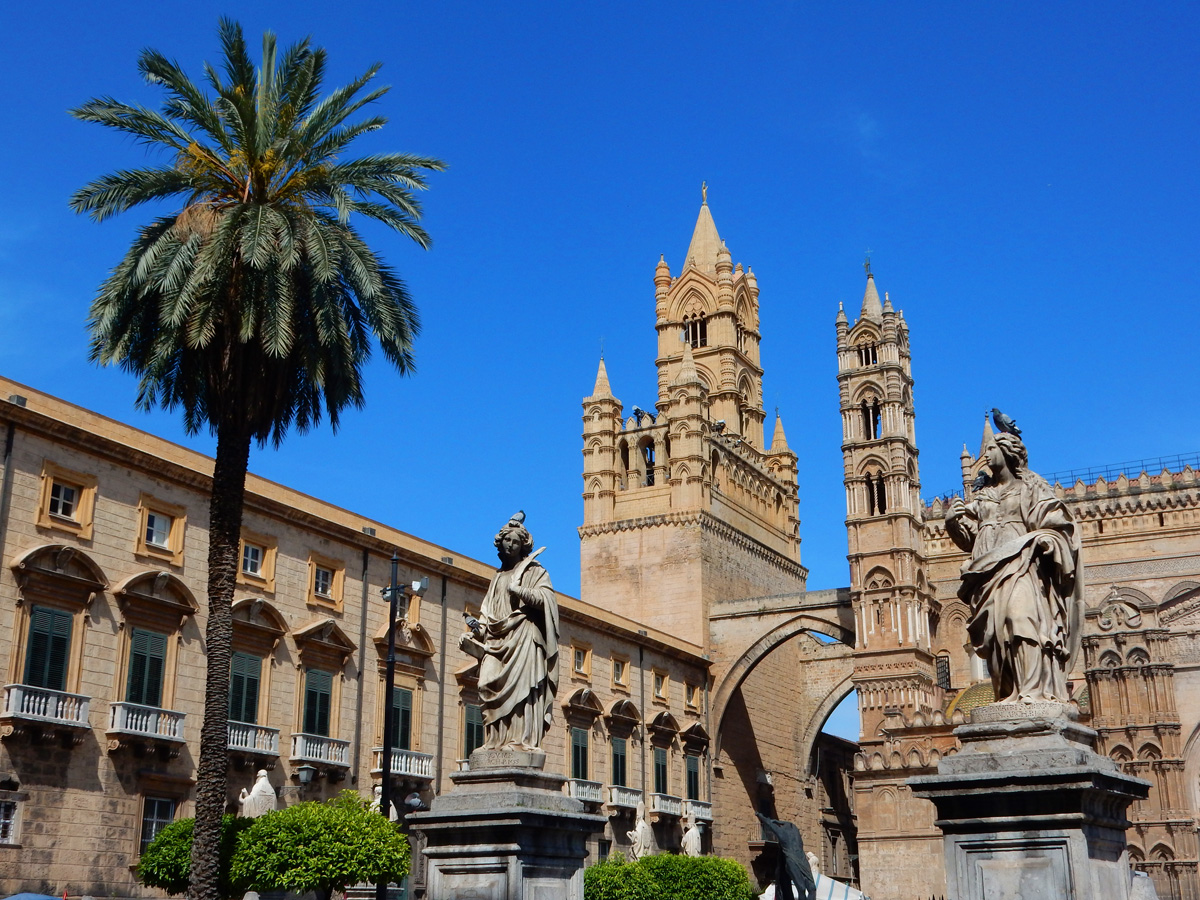 |
|||
| The two buildings shown here are joined by two Gothic arches spanning that narrow street I mentioned earlier. What was the purpose of those arches? Were they horizontal flying buttresses to help the two buildings withstand earthquakes? | |||
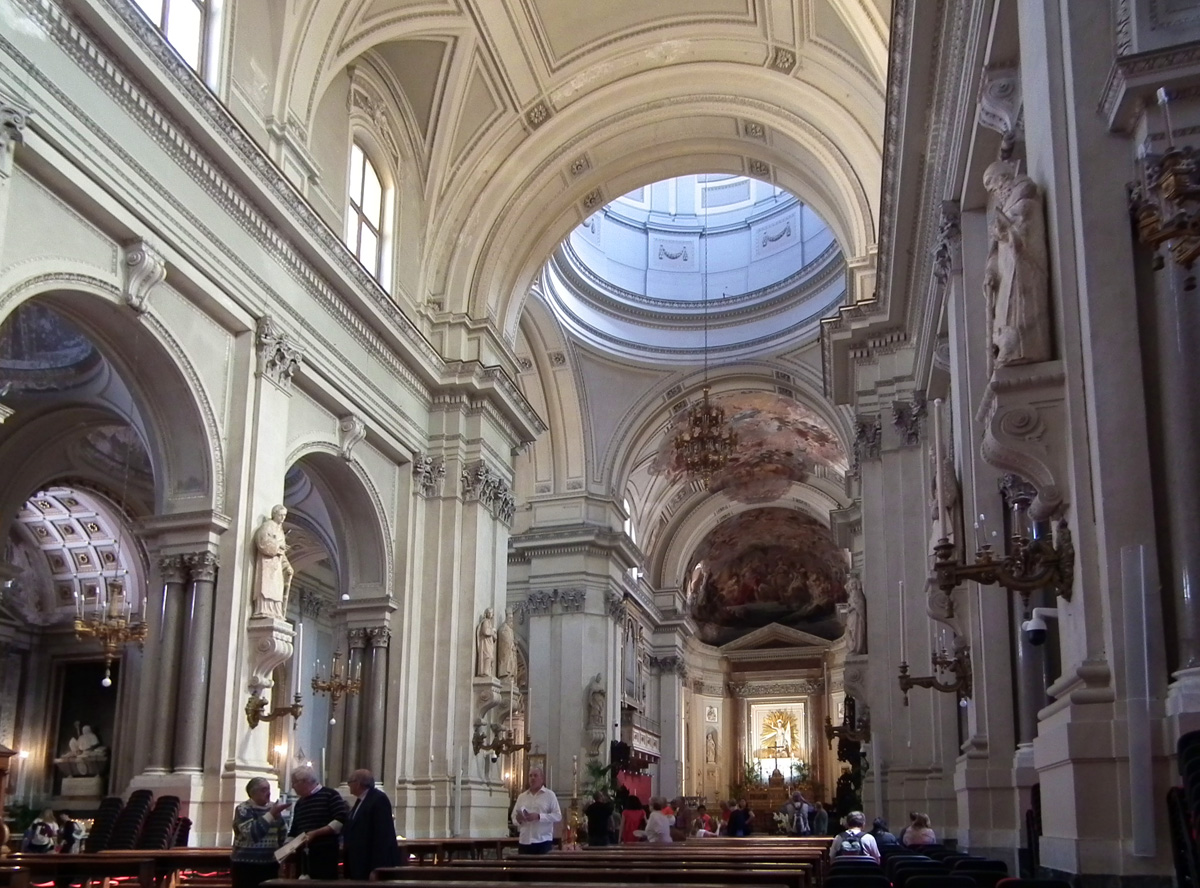 |
|||
| The austere Classical interior of the Duomo of Palermo. | |||
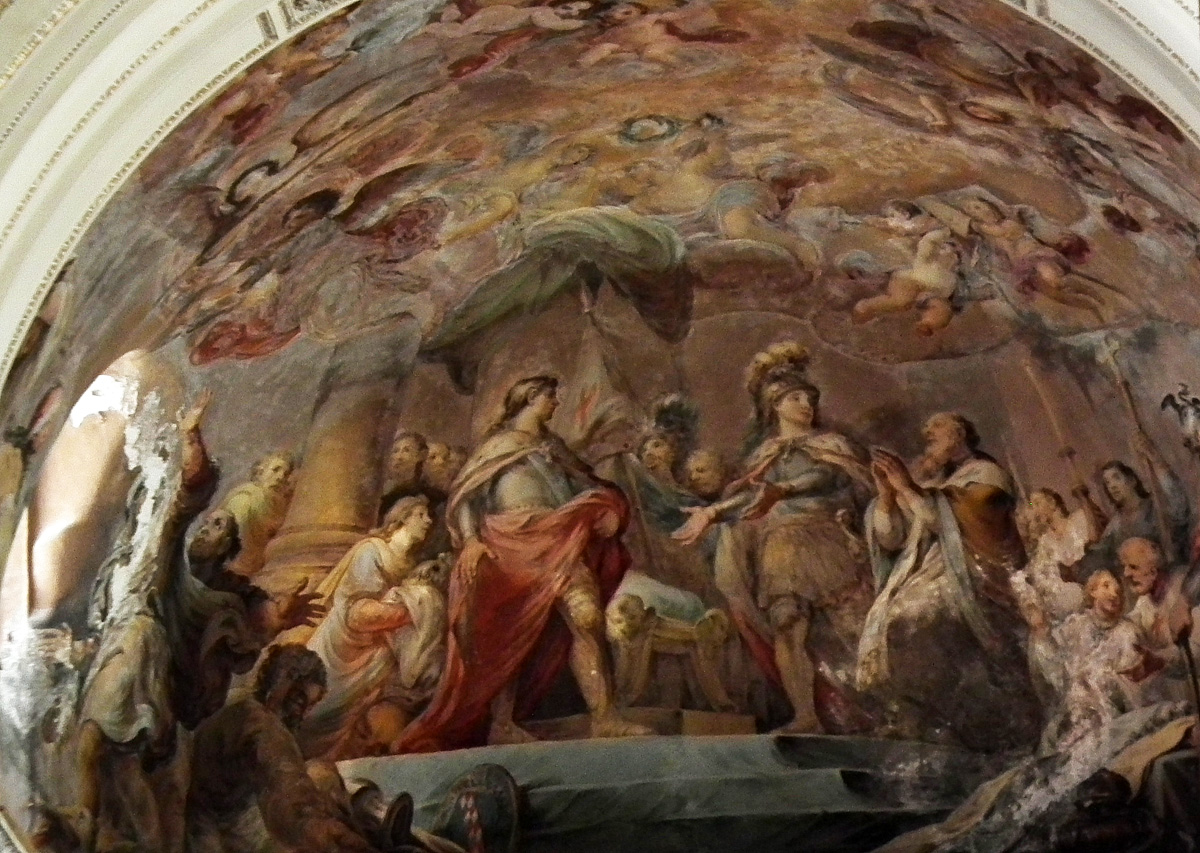 |
|||
| The fresco in the apse of the Duomo. | |||
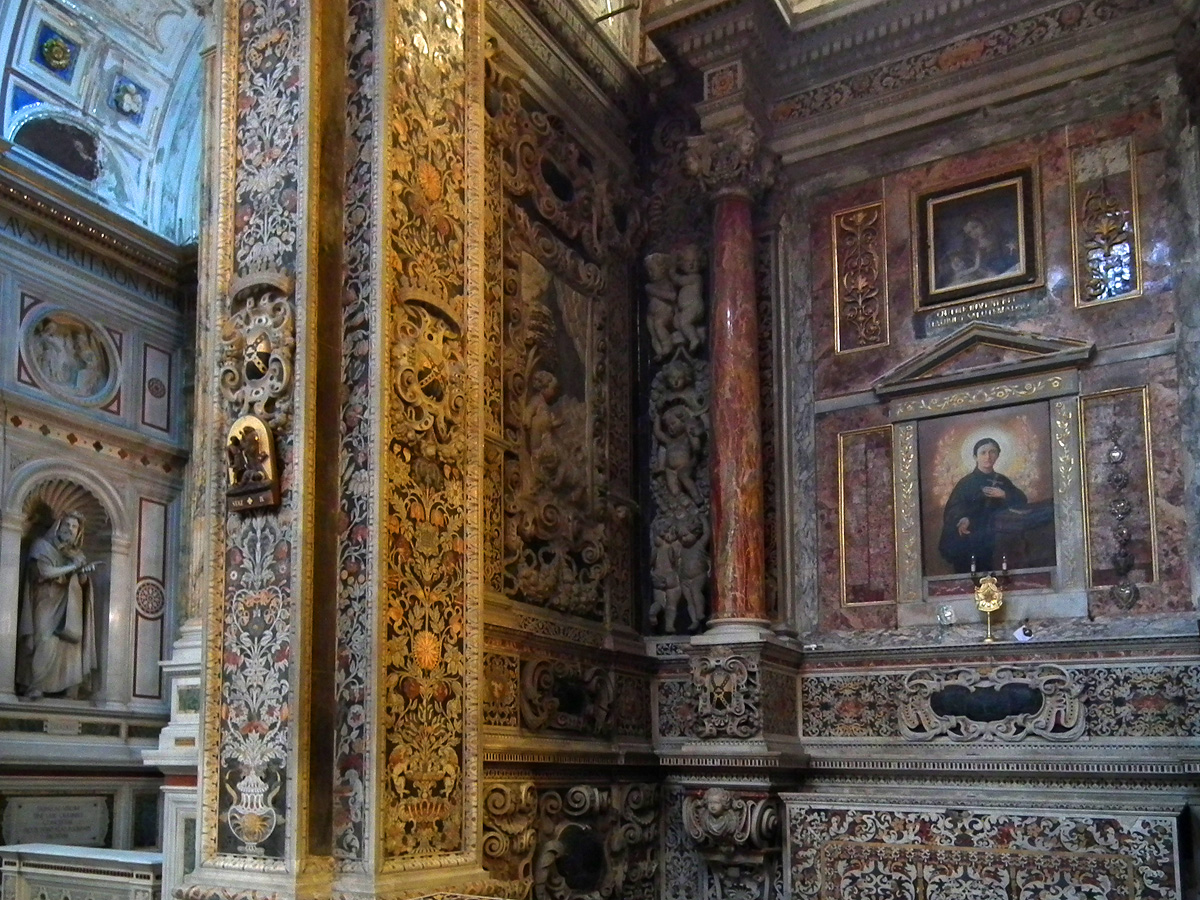 |
|||
| There are so many churches in Palermo and I cannot possibly fit them all in to this page. Here are just two images from the interior of a lovely Baroque Church in Palermo. It is the Church of Saint Ignatius at Olivella, just off the Via Roma. I was particularly impressed by the marble inlays on the columns and altars. | |||
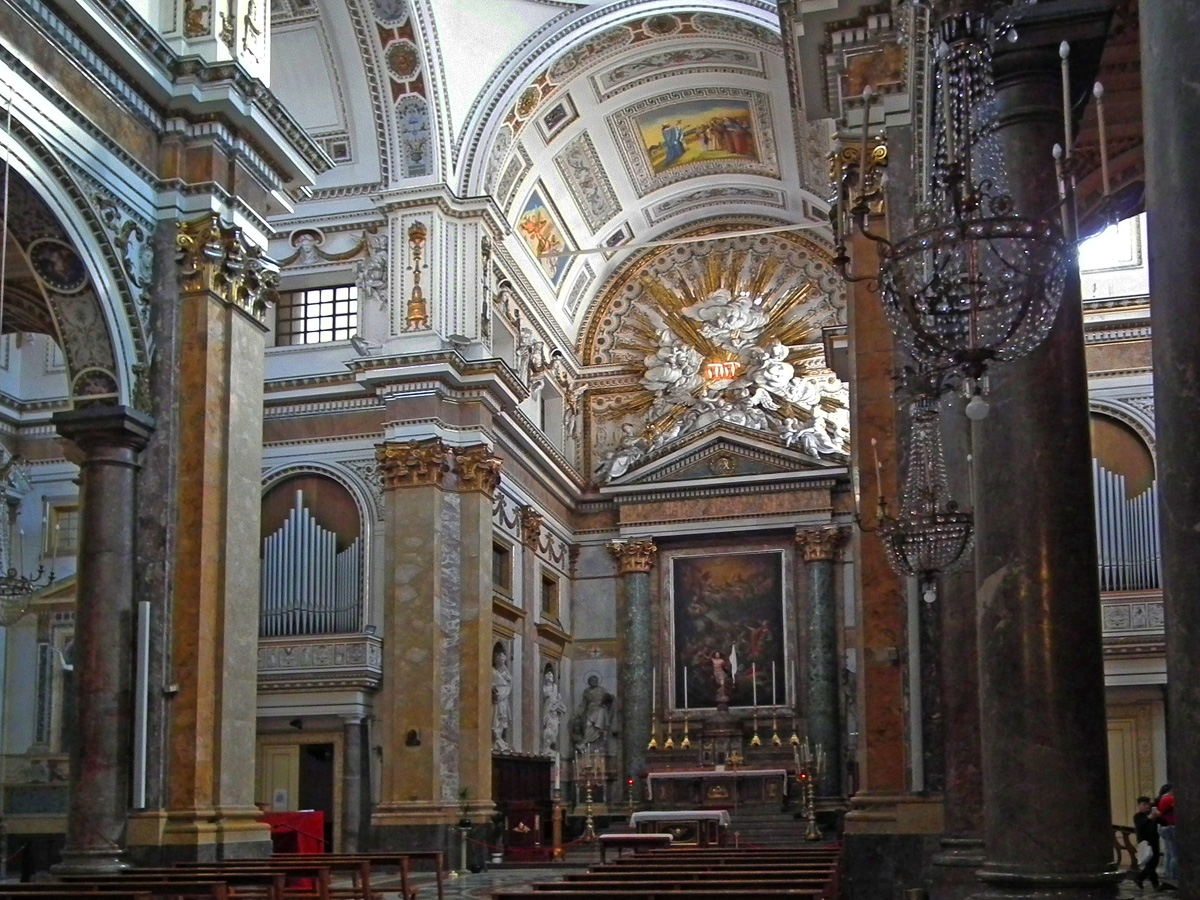 |
|||
| Saint Ignatius at Olivella. | |||
 |
||||
| The facade of Saint Ignatius at Olivella. | ||||
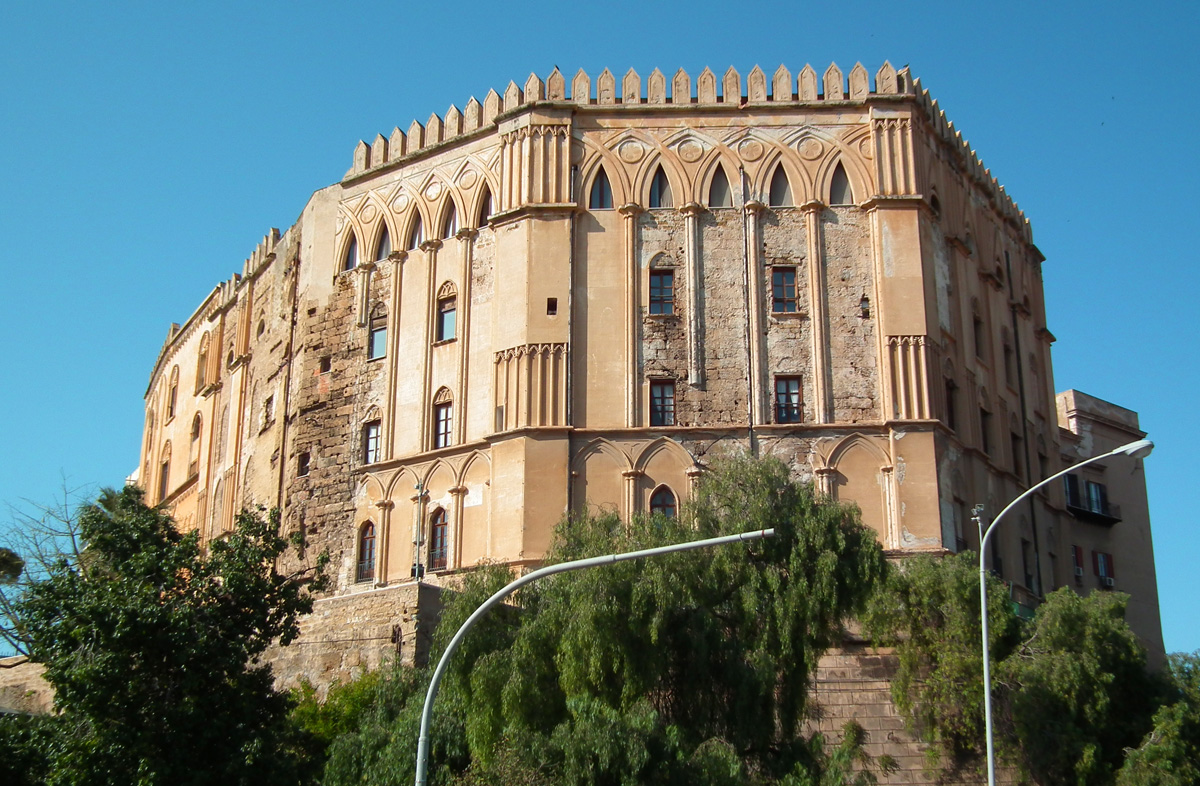 |
|||||
| I have left the best to the very last. We finally arrive at the Norman Palace which houses the fabulous Palatine Chapel of Roger II (Cappella Palatina). Alas, the rest of the Norman Palace has been ravaged over the centuries by the infamous Cult of the New. Gorgeous old mosaics and frescos have been replaced by hideous Baroque "fire-places". | How did the Cappella Palatina manage to avoid being desecrated by the Cult of the New?
When I was in Palermo for the very first time, several decades ago, I heard a lovely story which I can only hope to be true. According to this legend, somehow the Palatine Chapel became sealed off from the rest of the Norman Palace and remained completely hidden for centuries. Then, during the Risorgimento, when Garibaldi was leading the charge to unify Italy, there was an upsurge of interest in Italy's past, and local historical societies arose spontaneously all over the brand new country. In Palermo, the local historical society began a project to make a complete inventory of the Norman Palace of Palermo. Precise measurements were taken of all the rooms. During this process, the local historians began to realise that a large chunk of the Palace seemed to be missing... or hidden. Very carefully, they knocked a small hole in one of the walls and crawled through with lighted torches. Lo and behold, they had rediscovered the undisturbed Cappella Palatina of Roger II. Such a romantic account fully deserves to be believed! |
||||
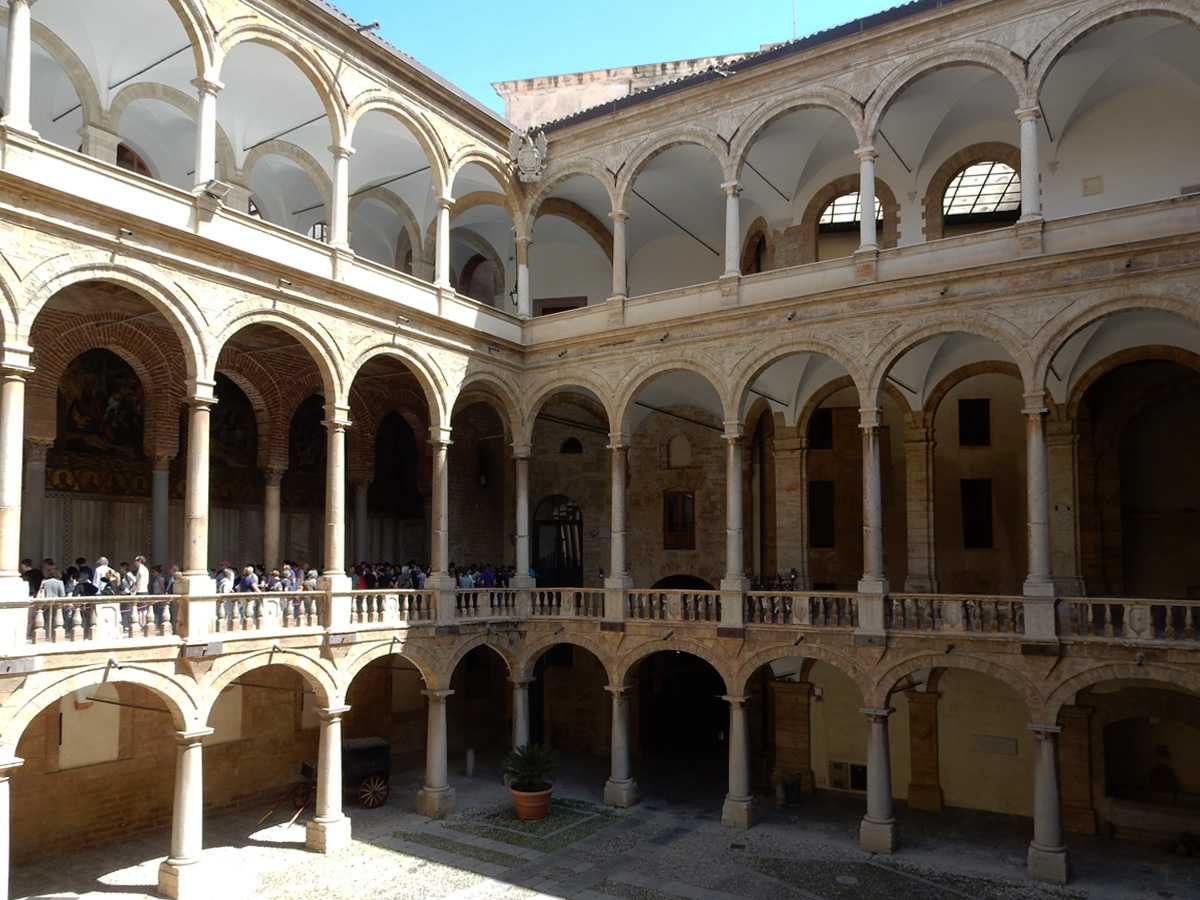 |
|||
| The Renaissance courtyard of the Norman Palace. The queue of people on the left are waiting patiently for their turn to enter the Palatine Chapel. | |||
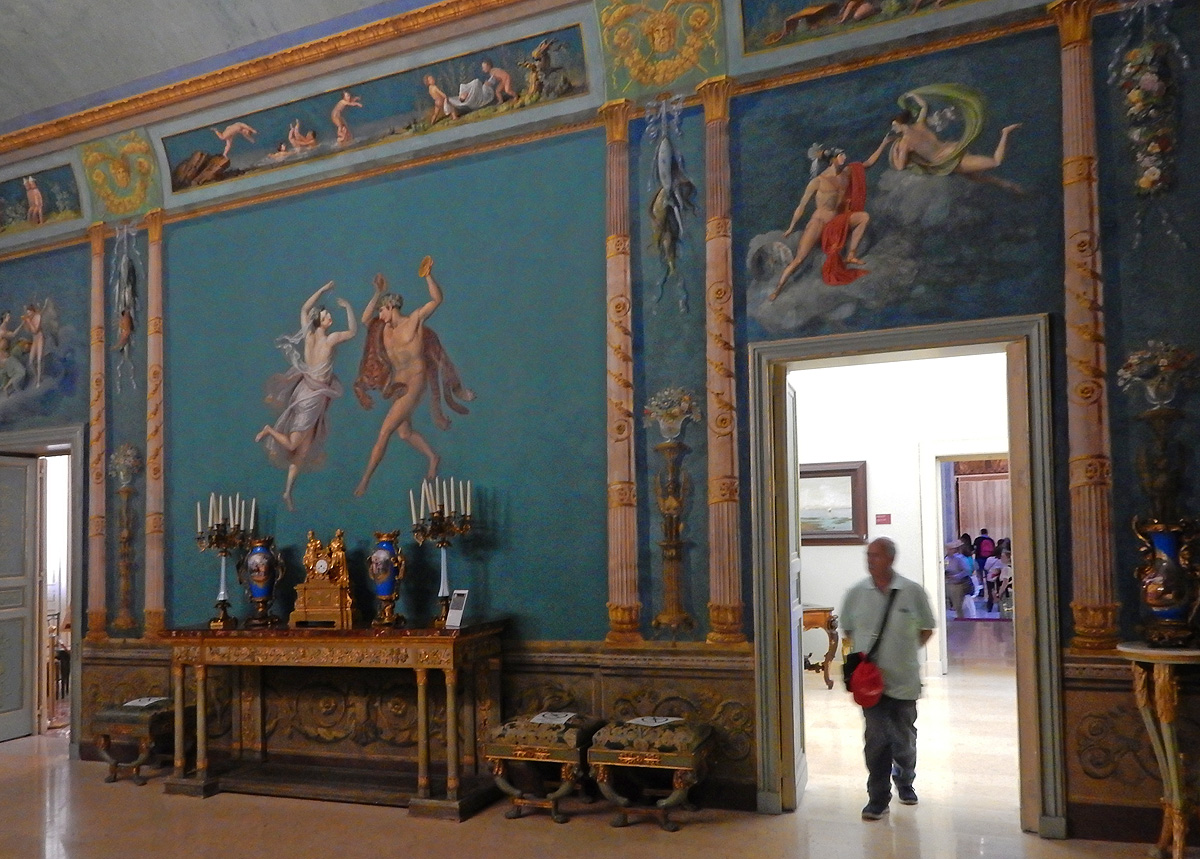 |
|||
| Just one example of the boring redecorated rooms in the Norman Palace. I will spare you the pain of looking at the others. | |||
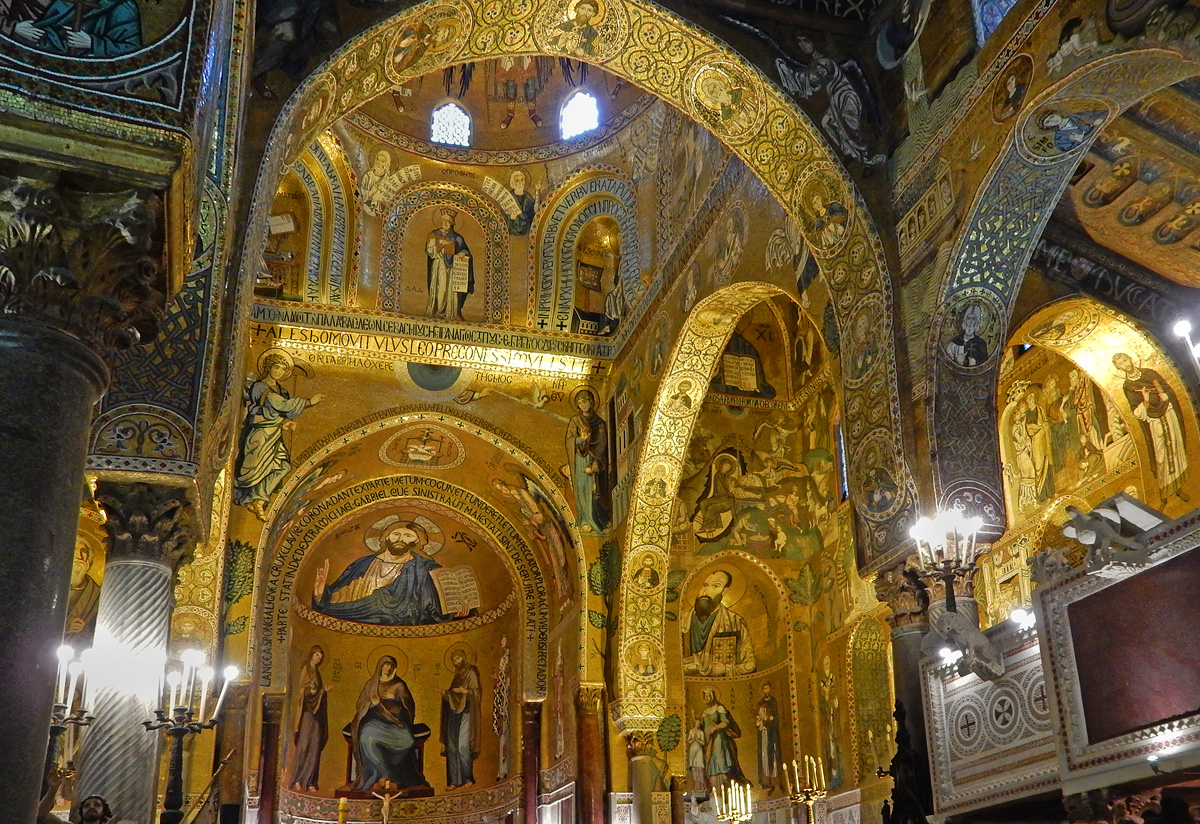 |
|||
| You have waited long enough. This is the Palatine Chapel. The first time I saw it, decades ago, I had what I could only describe as an "aesthetic orgasm".
My whole body shook with pleasure. |
|||
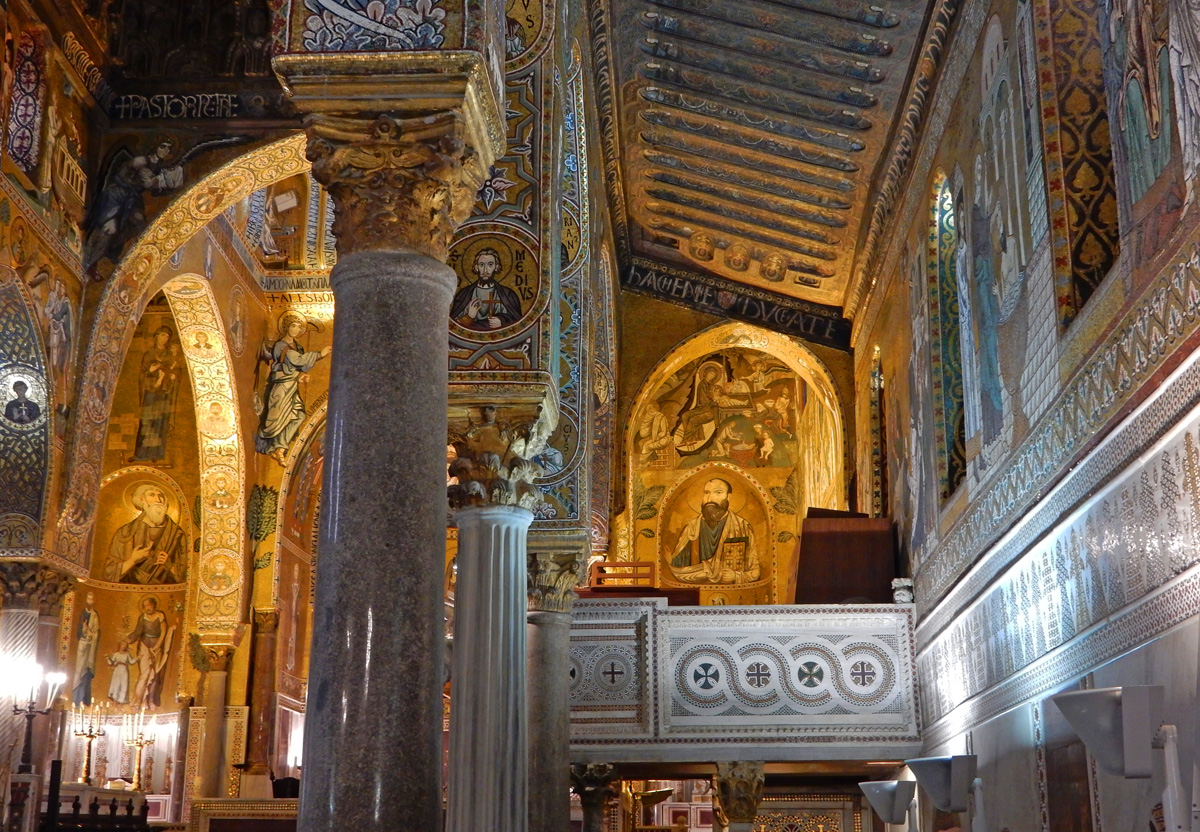 |
||
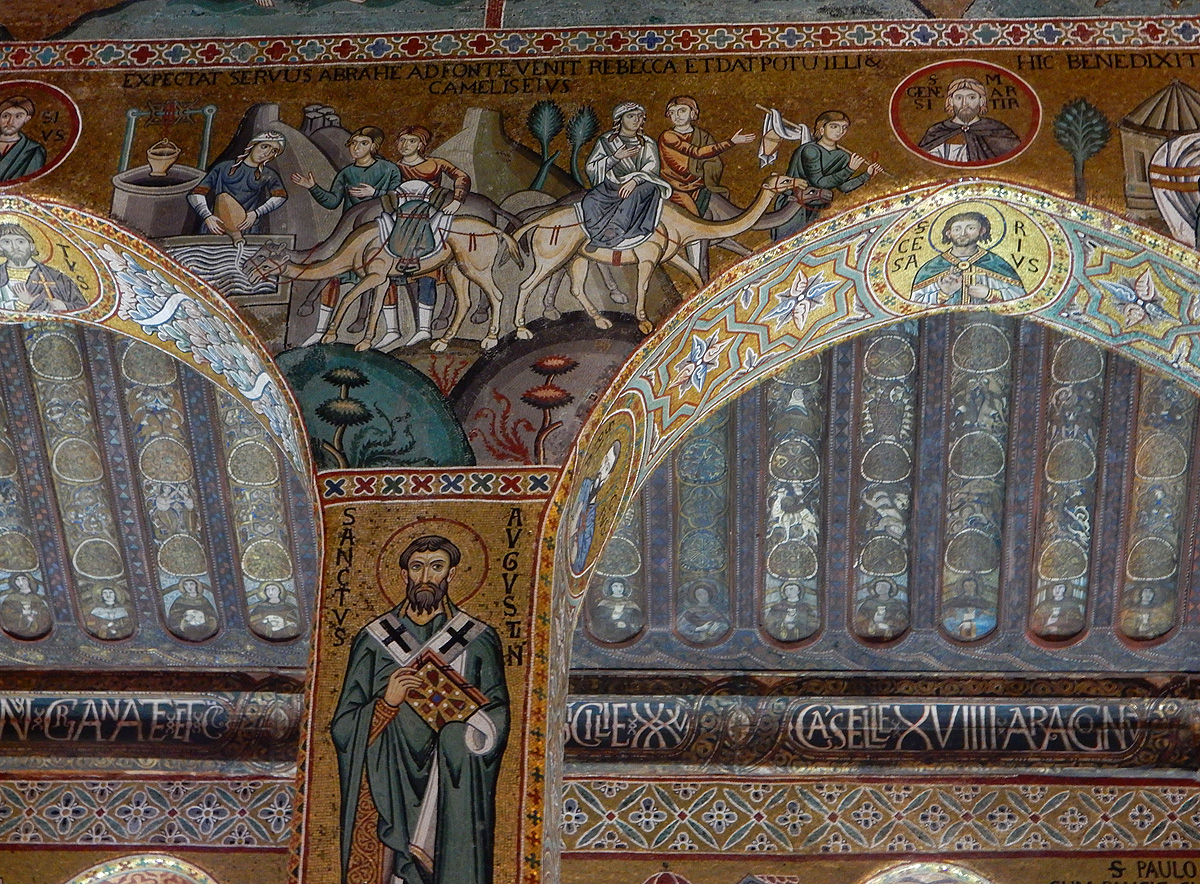 |
||
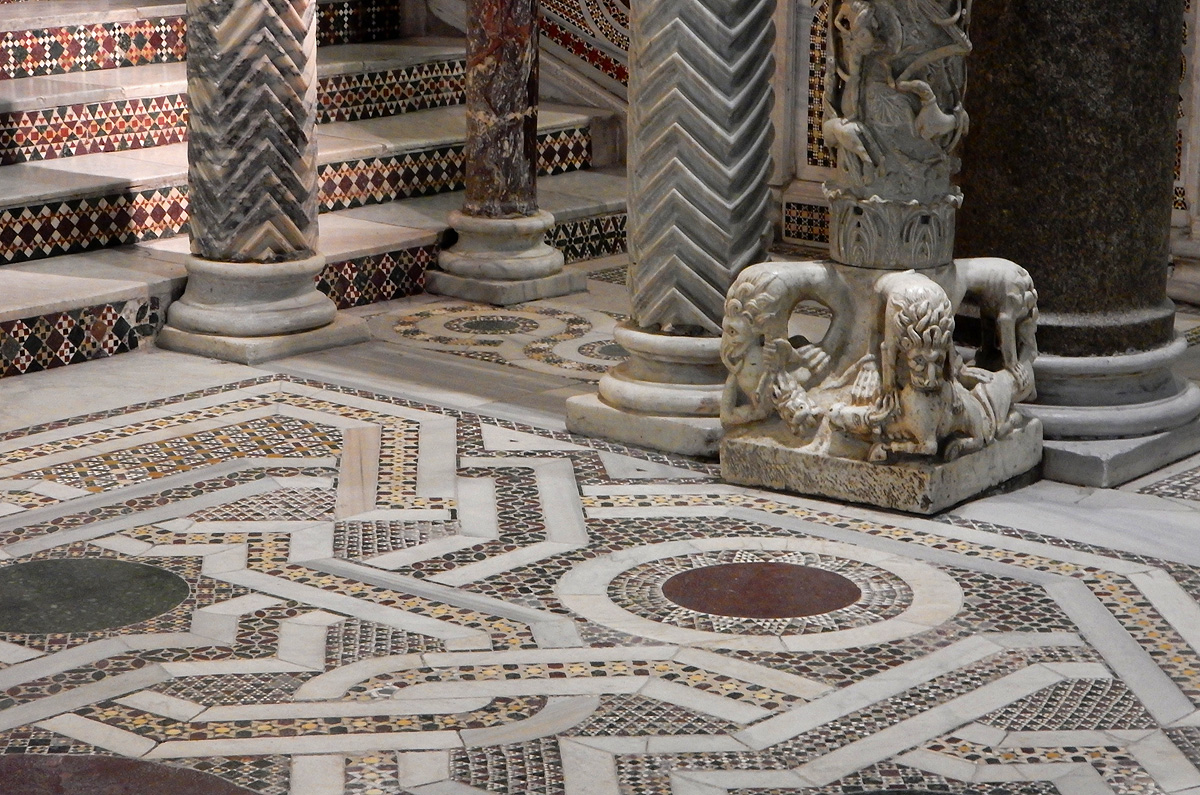 |
|||
| The Palatine Chapel was commissioned by Roger II in 1132 AD and it took eight years to build. It is a prime example of the fusion of cultures practised in the court of Roger II.
The basic architecture is Norman. The floor was made by the best Roman tile-layers. The walls were covered in Byzantine mosaics; and the ceiling was made and painted by top Islamic craftsmen imported from Cairo. |
|||
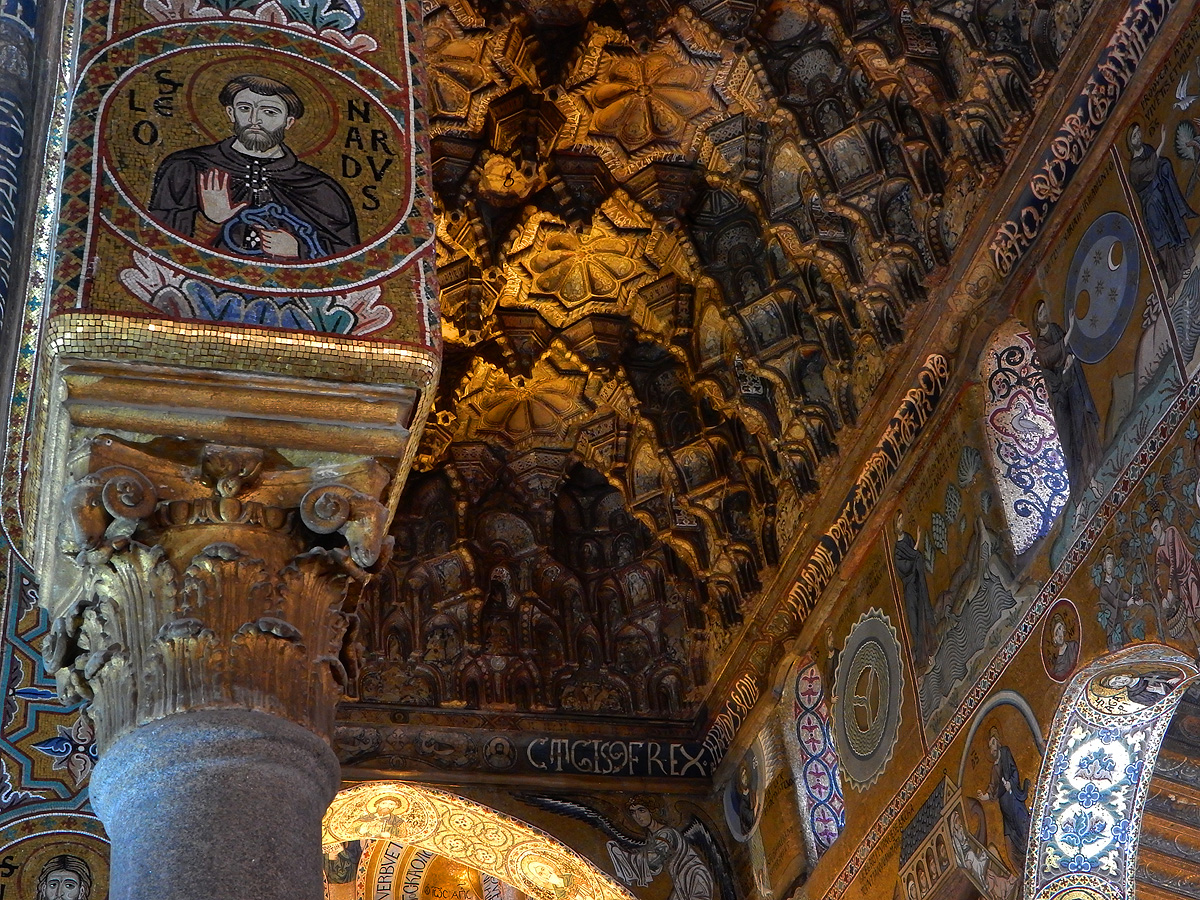 |
|||
| The Arab ceiling of the Palatine Chapel in the Nave of the Chapel. This type of ceiling is known as Muqarnas.
Note also that the columns were recycled from the Pagan temples of the Ancient Greeks. |
|||
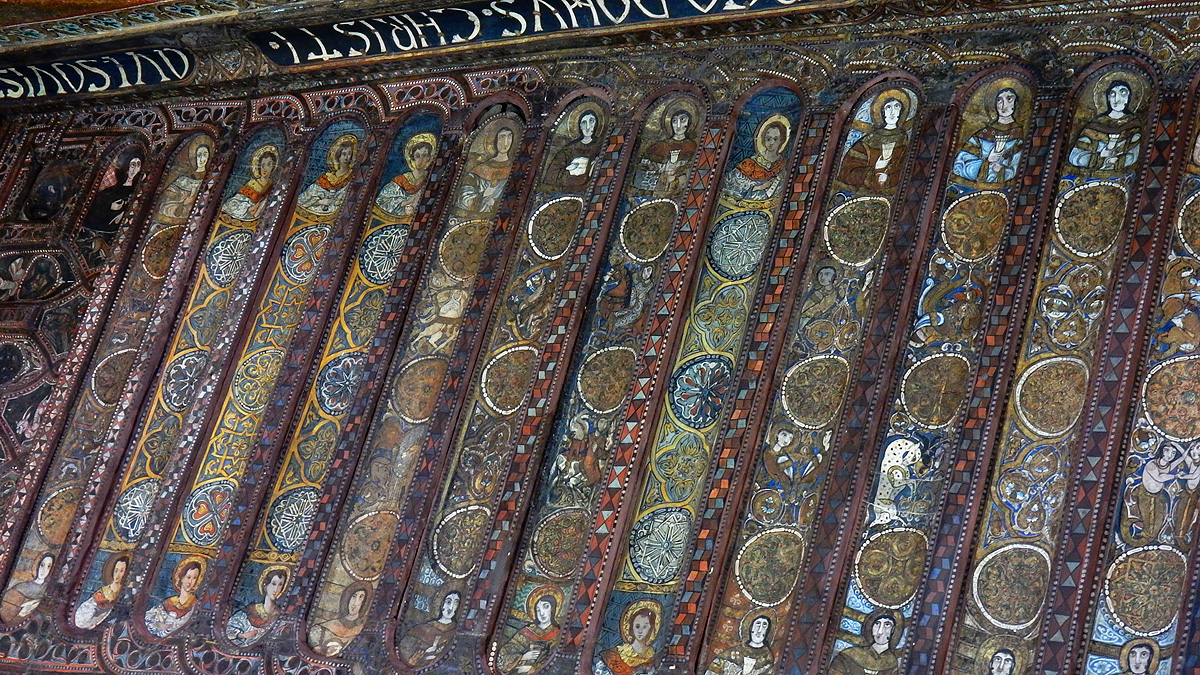 |
|||
| The ceilings in the two aisles of the Chapel are decorated with Christian symbols. | |||
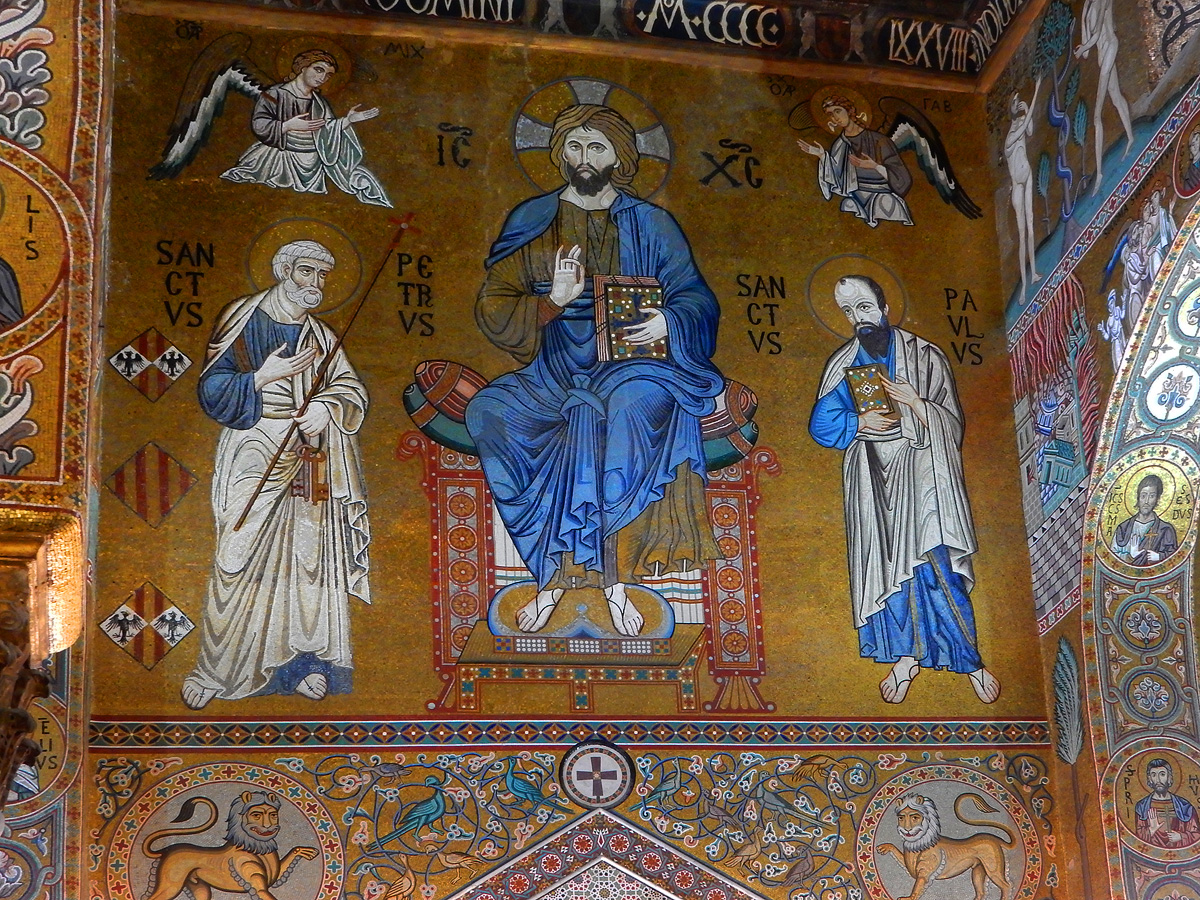 |
||
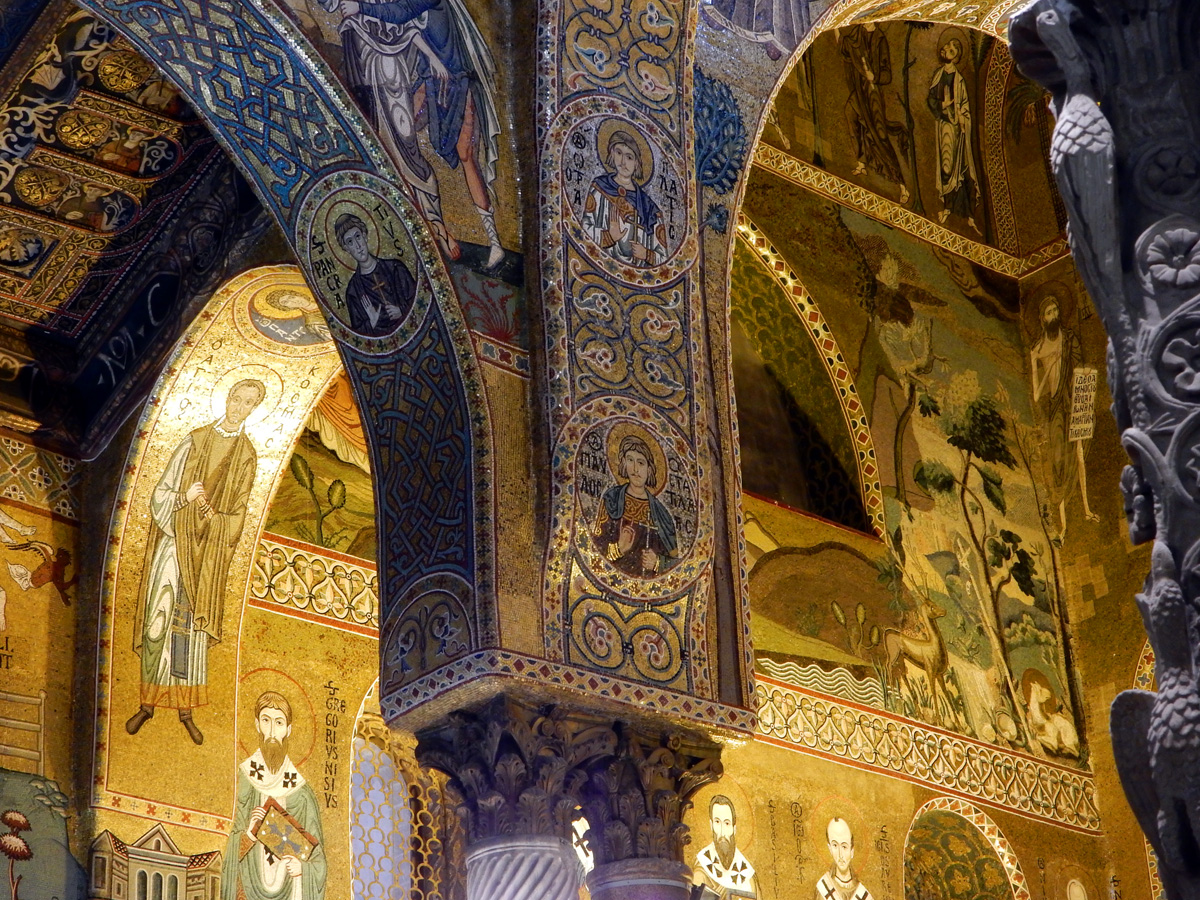 |
||
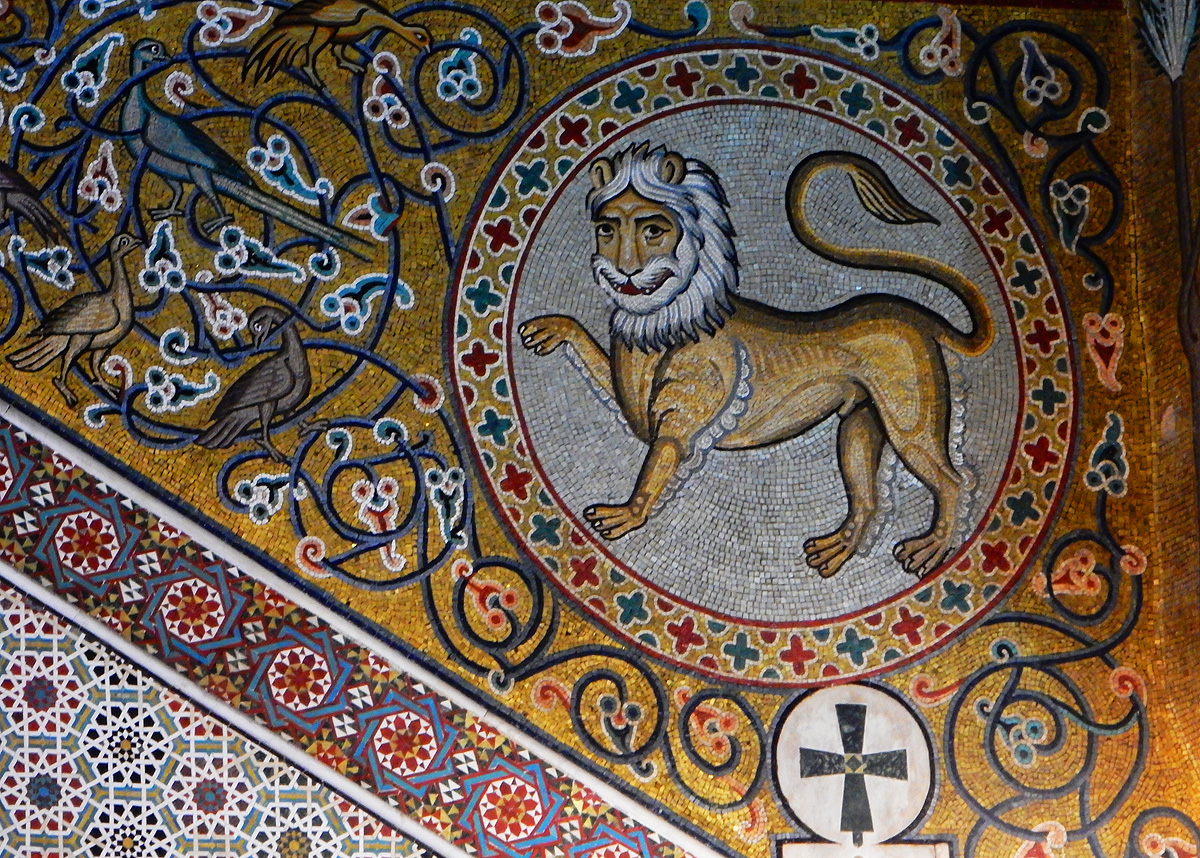 |
|||
| I just love the lion's moustache!
Also, take note of the Arabic 8-pointed stars in the diagonal strip. The birds and foliage in the decoration would not be out of place in a mosque in Istanbul. |
|||
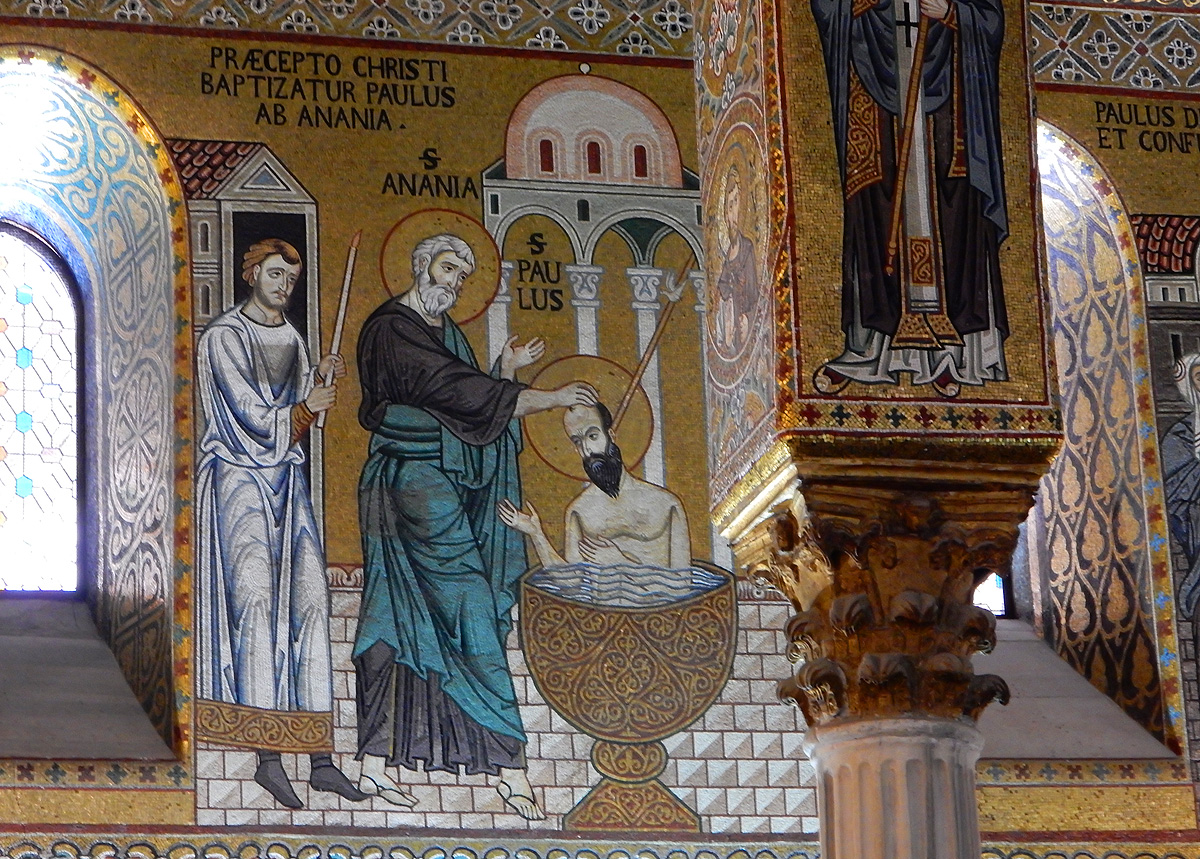 |
||
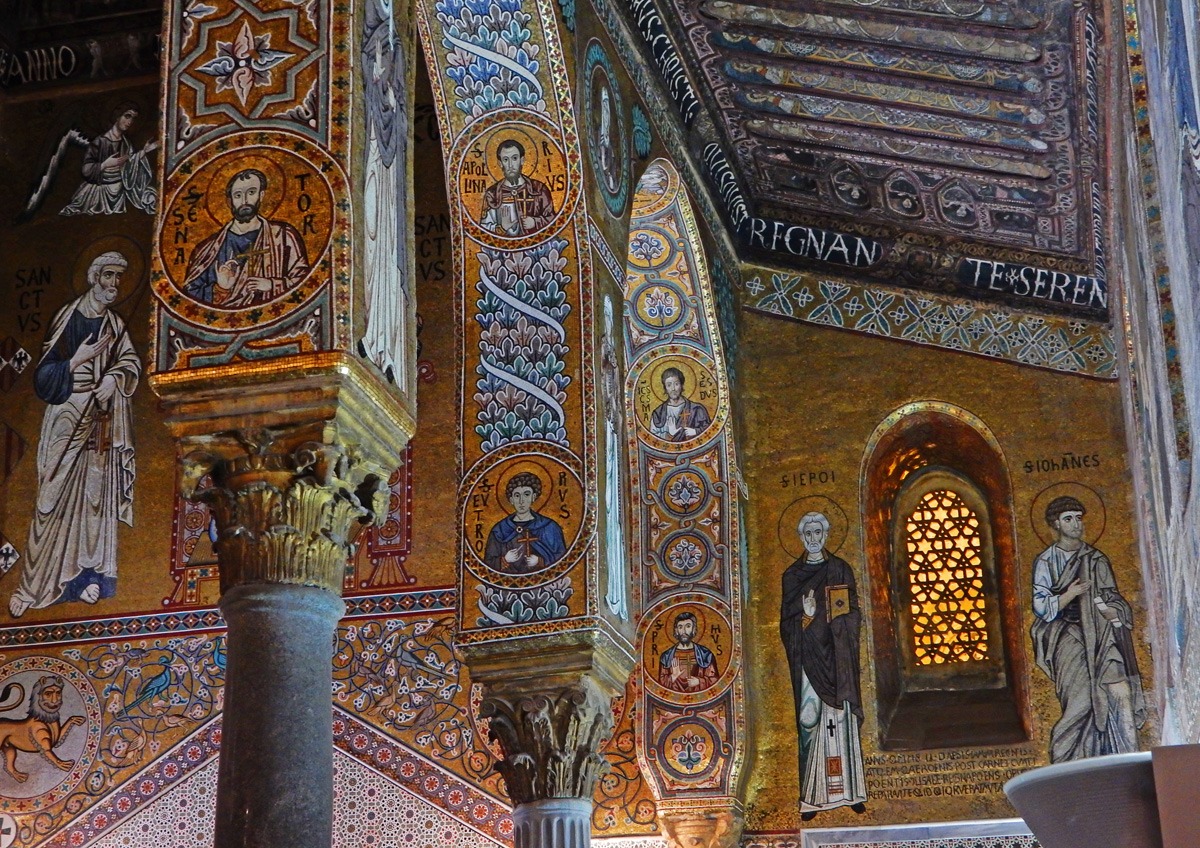 |
|||
| With this last image from the Cappella Palatina, we say farewell to Palermo. | |||
|
To return to the Paintings section of this website, please CLICK HERE
|
|||